Paul van Yperen's Blog, page 365
November 3, 2015
Marcelino, pan y vino (1955)
The Spanish tragi-comedy Marcelino, pan y vino/The Miracle of Marcelino (Ladislao Vajda, 1955) was an international success. It made little Pablito Calvo (1948–2000) a European film star.

Italian postcard by Ed. Villaggio del Fanciullo, Bologna. Photo: E.N.I.C. Publicity still for Marcelino, pan y vino/The Miracle of Marcelino (1955).

Italian postcard by Ed. Villaggio del Fanciullo, Bologna. Photo: E.N.I.C. Publicity still for Marcelino, pan y vino/The Miracle of Marcelino (1955).

Italian postcard by Ed. Villaggio del Fanciullo, Bologna. Photo: E.N.I.C. Publicity still for Marcelino, pan y vino/The Miracle of Marcelino (1955).
Orphan in a monastery
Pablito Calvo was 8 years old when he played the lead role in Marcelino, pan y vino (1955), literally Marcelino, bread and wine.
The Spanish film was written by José María Sánchez Silva, who based it on his novel, and directed by Ladislao Vajda. The story, revised and modernised in both the book and film, dates back to a medieval legend, one of many gathered together in a volume by Alfonso el Sabio. Cinematographer Heinrich Gartner was responsible for the beautiful black-and-white photography.
Pablito plays Marcelino, an orphan abandoned as a baby on the doorstep of a monastery in nineteenth-century Spain. The monks raise the child, and Marcelino grows into a a mischievous young sprout. Yearning for friends his own age, the boy inadvertently causes all sorts of havoc. One day when he eats his small meal in a room full of old things, he gives a piece of his bread to an old wooden Jesus figure - and indeed it takes the bread and eats it. Getting a wish granted for his donation Marcelino wishes to see his mother...
At the 1955 Cannes Film Festival the film won an award, and at the 5th Berlin International Film Festival it won the Silver Bear. Pablito, who had received a special mention from the Cannes festival jury, became Spain's most famous child actor. The film became one of the first Spanish films to become successful in the USA.
The following year Pablito appeared in Mi tío Jacinto/Pepote (Ladislao Vajda, 1956) which won the Golden Bear (Audience Award) at the Berlin International Film Festival. After some more films, he retired from acting in 1963. He was 16 and had decided to become an industrial engineer.
Marcelino, pan y vino (1955) remains one of the most famous and successful Spanish films ever made. There were many remakes, including a Philippine TV version, Marcelino pan y vino (Mario O'Hara, 1979), an Italian remake, Marcellino (Luigi Comencini, 1991), an animated TV series, Marcelino Pan y Vino (2000-2001, 2004), and a Mexican remake, Marcelino Pan y Vino (Jose Luis Gutierrez, 2010), with the basic storyline and framed by the Mexican Revolution of 1910. None of these remakes was as successful as the original.
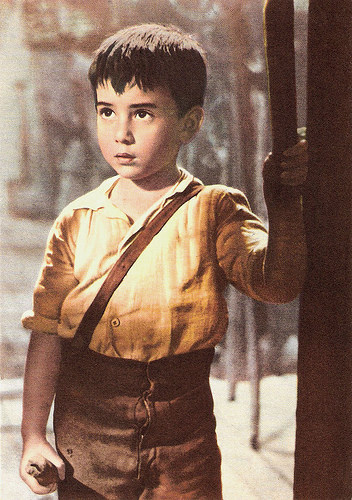
Italian postcard by Ed. Villaggio del Fanciullo, Bologna. Photo: E.N.I.C. Publicity still for Marcelino, pan y vino/The Miracle of Marcelino (1955).
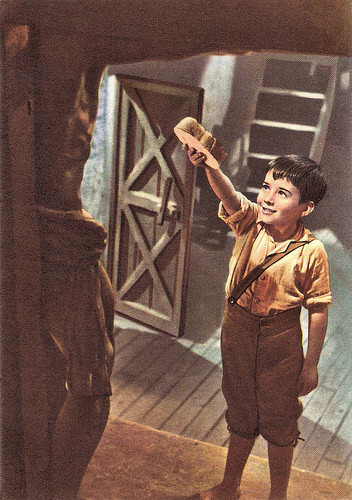
Italian postcard by Ed. Villaggio del Fanciullo, Bologna. Photo: E.N.I.C. Publicity still for Marcelino, pan y vino/The Miracle of Marcelino (1955).
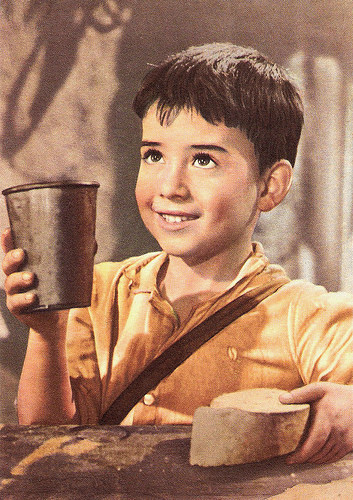
Italian postcard by Ed. Villaggio del Fanciullo, Bologna. Photo: E.N.I.C. Publicity still for Marcelino, pan y vino/The Miracle of Marcelino (1955).
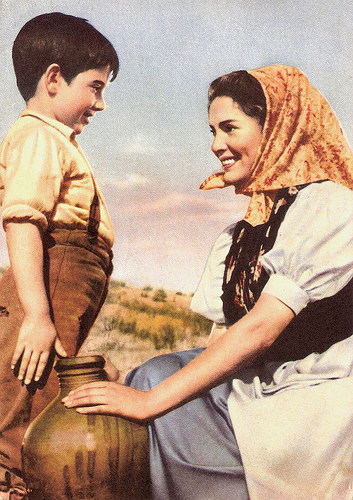
Italian postcard by Ed. Villaggio del Fanciullo, Bologna. Photo: E.N.I.C. Publicity still for Marcelino, pan y vino/The Miracle of Marcelino (1955) with Pablito Calvo and Rosita Valero.
Spanish trailer for Marcelino, pan y vino/The Miracle of Marcelino (1955) with the voice of Fernando Rey. Source: Ce Blacas (YouTube).
Sources: Hal Erickson (AllMovie), Volker Boehm (IMDb), Wikipedia and IMDb.

Italian postcard by Ed. Villaggio del Fanciullo, Bologna. Photo: E.N.I.C. Publicity still for Marcelino, pan y vino/The Miracle of Marcelino (1955).

Italian postcard by Ed. Villaggio del Fanciullo, Bologna. Photo: E.N.I.C. Publicity still for Marcelino, pan y vino/The Miracle of Marcelino (1955).

Italian postcard by Ed. Villaggio del Fanciullo, Bologna. Photo: E.N.I.C. Publicity still for Marcelino, pan y vino/The Miracle of Marcelino (1955).
Orphan in a monastery
Pablito Calvo was 8 years old when he played the lead role in Marcelino, pan y vino (1955), literally Marcelino, bread and wine.
The Spanish film was written by José María Sánchez Silva, who based it on his novel, and directed by Ladislao Vajda. The story, revised and modernised in both the book and film, dates back to a medieval legend, one of many gathered together in a volume by Alfonso el Sabio. Cinematographer Heinrich Gartner was responsible for the beautiful black-and-white photography.
Pablito plays Marcelino, an orphan abandoned as a baby on the doorstep of a monastery in nineteenth-century Spain. The monks raise the child, and Marcelino grows into a a mischievous young sprout. Yearning for friends his own age, the boy inadvertently causes all sorts of havoc. One day when he eats his small meal in a room full of old things, he gives a piece of his bread to an old wooden Jesus figure - and indeed it takes the bread and eats it. Getting a wish granted for his donation Marcelino wishes to see his mother...
At the 1955 Cannes Film Festival the film won an award, and at the 5th Berlin International Film Festival it won the Silver Bear. Pablito, who had received a special mention from the Cannes festival jury, became Spain's most famous child actor. The film became one of the first Spanish films to become successful in the USA.
The following year Pablito appeared in Mi tío Jacinto/Pepote (Ladislao Vajda, 1956) which won the Golden Bear (Audience Award) at the Berlin International Film Festival. After some more films, he retired from acting in 1963. He was 16 and had decided to become an industrial engineer.
Marcelino, pan y vino (1955) remains one of the most famous and successful Spanish films ever made. There were many remakes, including a Philippine TV version, Marcelino pan y vino (Mario O'Hara, 1979), an Italian remake, Marcellino (Luigi Comencini, 1991), an animated TV series, Marcelino Pan y Vino (2000-2001, 2004), and a Mexican remake, Marcelino Pan y Vino (Jose Luis Gutierrez, 2010), with the basic storyline and framed by the Mexican Revolution of 1910. None of these remakes was as successful as the original.

Italian postcard by Ed. Villaggio del Fanciullo, Bologna. Photo: E.N.I.C. Publicity still for Marcelino, pan y vino/The Miracle of Marcelino (1955).

Italian postcard by Ed. Villaggio del Fanciullo, Bologna. Photo: E.N.I.C. Publicity still for Marcelino, pan y vino/The Miracle of Marcelino (1955).

Italian postcard by Ed. Villaggio del Fanciullo, Bologna. Photo: E.N.I.C. Publicity still for Marcelino, pan y vino/The Miracle of Marcelino (1955).

Italian postcard by Ed. Villaggio del Fanciullo, Bologna. Photo: E.N.I.C. Publicity still for Marcelino, pan y vino/The Miracle of Marcelino (1955) with Pablito Calvo and Rosita Valero.
Spanish trailer for Marcelino, pan y vino/The Miracle of Marcelino (1955) with the voice of Fernando Rey. Source: Ce Blacas (YouTube).
Sources: Hal Erickson (AllMovie), Volker Boehm (IMDb), Wikipedia and IMDb.
Published on November 03, 2015 22:00
November 2, 2015
Nadja Tiller
Austrian actress Nadja Tiller (1929) was one of the vamps of the European cinema of the 1950s and 1960s. Her international breakthrough role was that of the high class prostitute Rosemarie Nitribitt in Das Mädchen Rosemarie/Rosemary (1958).
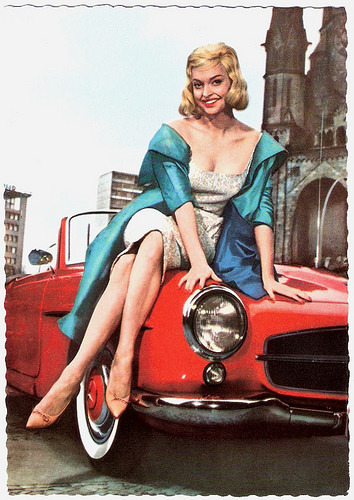
German postcard by Ufa, Berlin-Tempelhoff, no. CK-170. Photo: Klaus Collignon / Ufa. Publicity still for Das Mädchen Rosemarie/The Girl Rosemarie (Rolf Thiele, 1958).
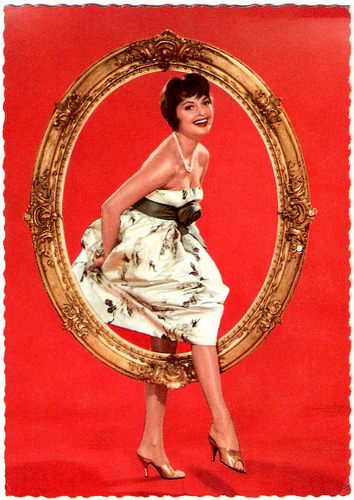
German postcard by Ufa, Berlin-Tempelhoff, no. CK 216. Photo: Klaus Collignon / Ufa.
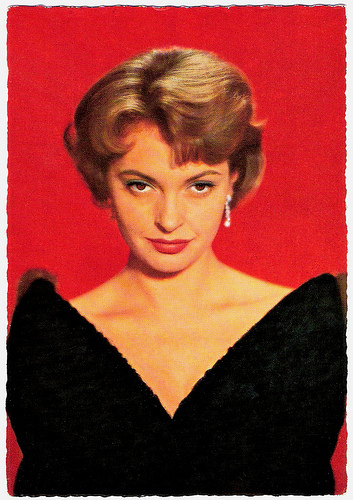
German postcard by WS-Druck, Wanne-Eickel, no. F 136. Photo: DEB-Paris.
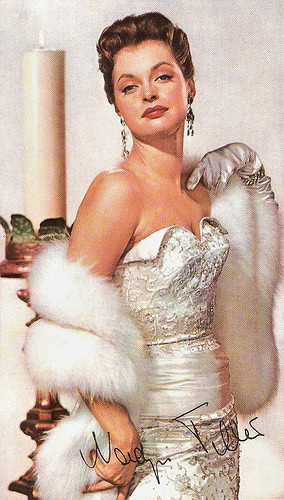
German promotion card for Luxor.
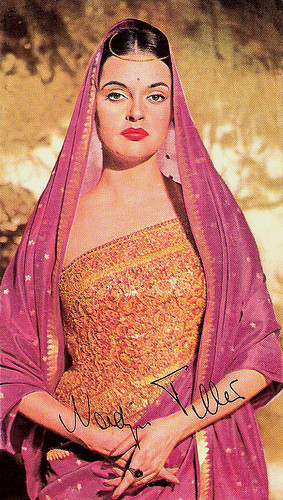
German promotion card for Lux Soap.
Miss Austria
Maria Nadja Tiller was born into a theatrical family in Vienna, Austria, in 1929. Her parents were the actor Anton Tiller and the operetta singer and actress Erika Körner.
From 1945 on, she studied at the Max-Reinhardt-Seminar and till 1949 at the Musik- und Schauspielakademie. She got an engagement at the Theater in der Josefstadt. Meanwhile she also worked as a model, and won the Miss Austria contest twice, in 1949 and 1951. The Miss Austria title caused her dismissal at the Theater in der Josefstadt, but it turned out to be her ticket into film making.
In 1949, she acted opposite O.W. Fischer in Märchen vom Glück/Kiss Me Casanova (Arthur de Glahs, 1949). Many roles as a vamp in German and Austrian light entertainment films followed.
In 1954 she worked with director Rolf Thiele in the successful Sie/She with Marina Vlady . Her next film for Thiele, Die Barrings/The Barrings (1955) with Dieter Borsche , became her artistic breakthrough. Until 1970 Thiele and Tiller would make eleven films together, including Friederike von Barring (1956) and Lulu/No Orchids for Lulu (1962), with Mario Adorf .
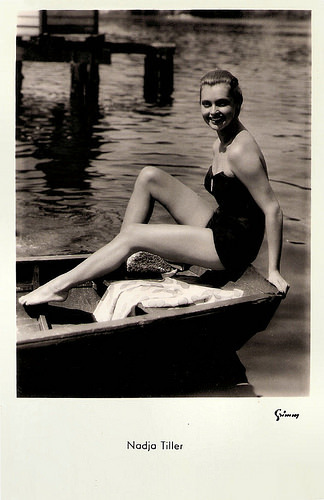
French postcard by Editions P.I., Paris, no. FK 3814. Photo: Arthur Grimm / Ufa.
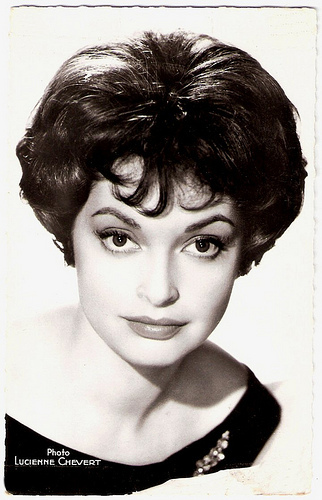
French postcard by Editions du Globe (E.D.U.G.), Paris, no. 812. Photo: Lucienne Chevert.
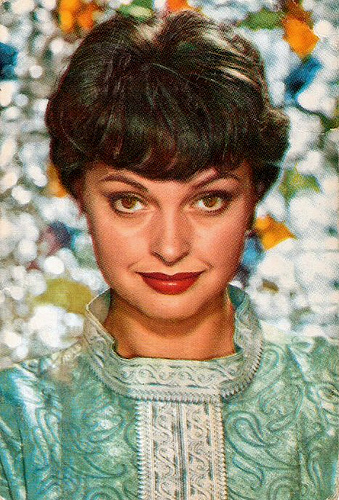
Belgian collectors card, no. 81. Photo: Klaus Collignon.
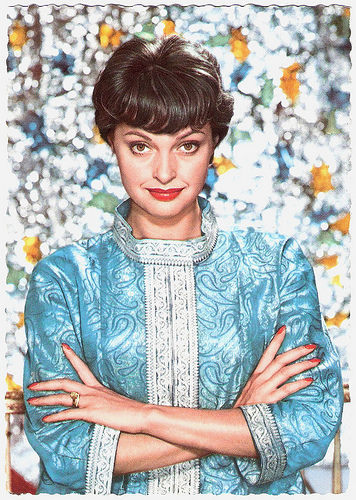
German postcard by Ufa, Berlin-Tempelhof, no. CK-215. Photo: Klaus Collignon / Ufa.
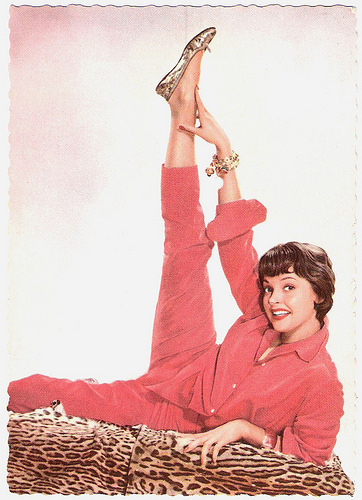
German postcard by Ufa, Berlin-Tempelhof, no. CK-205. Photo: Klaus Collignon / Ufa.
Scandal
Nadja Tiller’s international breakthrough role was that of the high class prostitute Rosemarie Nitribitt in Das Mädchen Rosemarie/Rosemary (Rolf Thiele, 1958). The film, based on a murder scandal of the year before, was a huge, international success. It confirmed the assumption of post-war, American audiences that European actresses were somehow more sensuous and erotic than their Hollywood counterparts.
Tiller won a Best Actress award at the Film Festival of Venice for the role. There she was offered roles in Antonioni's La notte (1961), Fellini's La dolce vita (1960), and Visconti's Rocco e i suoi fratelli/Rocco and his Brothers (1960), but she had to decline all three for familiar reasons (she was pregnant).
Later she would appear at the side of such international stars as Jean Gabin , Jean-Paul Belmondo , Rod Steiger, Yul Brynner and Michael Caine , but it did never bring her the status which she could have had with the three roles she had to say no to.
She did appear in the international productions The Rough and the Smooth (Robert Siodmak, 1959), Du Rififi chez les femmes/Rififi Among the Women (Alex Joffé, 1959) with Robert Hossein , An einem Freitag um halb zwölf/On Friday at Eleven (Alvin Rakoff, 1961), L'Affaire Nina B./The Nina B. Affair (Robert Siodmak, 1961), the thriller La chambre ardente/The Burning Court (Julien Duvivier, 1962), and Anima nera/Black Soul (Roberto Rossellini, 1962) with Vittorio Gassman , and she stayed popular among the art house public.
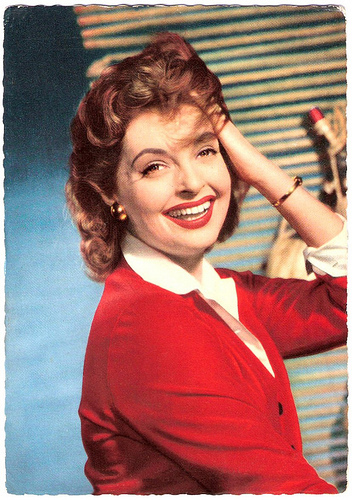
German postcard by Ufa (Universum-Film Aktiengesellschaft), Berlin-Tempelhof, no. CK-123. Photo: Arthur Grimm / Ufa.
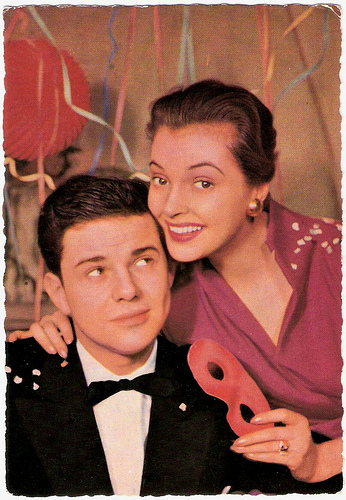
With husband Walter Giller . German postcard by WS-Druck, Wanne-Eickel, no. F 47. Photo: Huster.
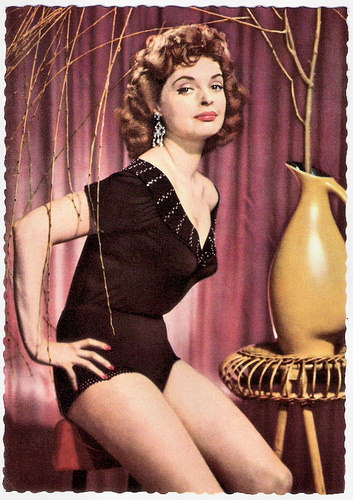
German postcard by Ufa, Berlin-Tempelhof, no. CK-14. Photo: Arthur Grimm.
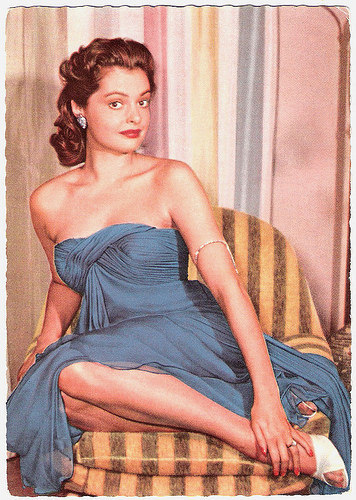
German postcard by Ufa, Berlin-Tempelhof, no. CK-106. Photo: Eberhardt Schmidt / Ufa.
Traumpaar
Nadja Tiller would act in more than 70 films, but since the 1970s she works mainly for theatre and television. During the 1970s and 1980s she worked for theatres in Lübeck, Berlin and Vienna. A great success was her leading role in the Kurt Weill musical Lady in the Dark.
In 1997 she appeared at the Hamburger Kammerspielen as the elder Hollywood diva Joan Crawford in the play Nächte mit Joan (Nights with Joan) by Cas Enklaar. A year later she also starred in the TV-adaptation directed by Horst Königstein with Rita Tushingham as Bette Davis.
Her most recent feature films were the road movie Barfuss/Barefoot (Til Schweiger, 2005) in which she played the mother of the main character played by director Til Schweiger himself, and the crime comedy Dinosaurier/Dinosurs (Leander Haussmann, 2009) with Eva-Maria Hagen .
In 1956, Nadja Tiller married actor Walter Giller , whom she had met at the set of the music film Schlagerparade/Hit Parade (Erik Ode, 1953). They were called the 'Traumpaar der Wirtschaftswunder-Ära' (Dream Couple of the Wirtschaftswunder era) in the 1950s, and often worked together.
Nadja Tiller was honoured with many awards, including the Bundesverdienstkreuz (Germany's Cross of Merit) in 2000. Together with her husband she received a Bambi Lifetime Achievement Award in 2005. Giller died in 2011. They had two children, Natascha (1959) and Jan-Claudius (1964). Nadja Tiller lives in a retirement home in Hamburg.
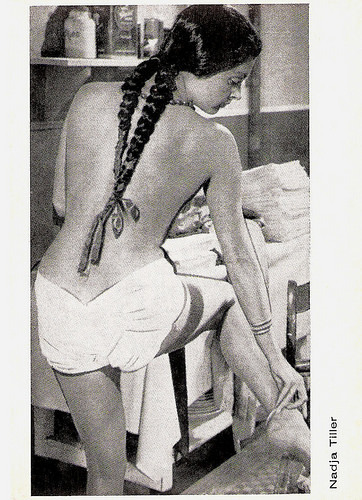
Vintage card.
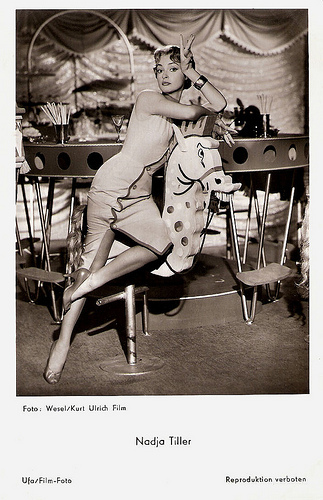
German postcard by Universum-Film Aktiengesellschaft (Ufa), Berlin-Tempelhof, no. FK 3842. Retail price: 25 Pfg. Photo: Wesel / Kurt Ulrich Film. Publicity still for 3 Mann auf einem Pferd/Three Men on a Horse (Kurt Meisel, 1957).
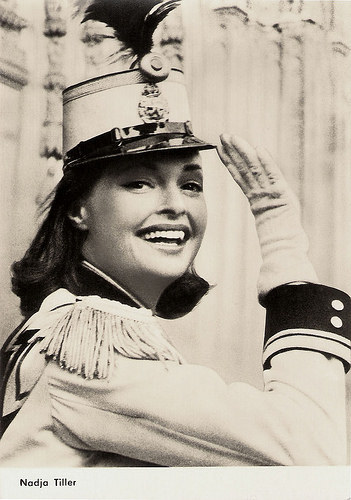
East-German postcard by VEB Progress Film-Vertrieb, Berlin, no. 2476, 1965.
A scene from Das Mädchen Rosemarie/Rosemary (Rolf Thiele, 1958). Source: sammy123de (YouTube).
Sources: Dieter Bartetzko (Frankfurter Allgemeine - German), Christian Schröder (Der Tagesspiegel - German), Stephanie D'heil (Steffi-line -German), Filmportal.de (German), , and Wikipedia.

German postcard by Ufa, Berlin-Tempelhoff, no. CK-170. Photo: Klaus Collignon / Ufa. Publicity still for Das Mädchen Rosemarie/The Girl Rosemarie (Rolf Thiele, 1958).

German postcard by Ufa, Berlin-Tempelhoff, no. CK 216. Photo: Klaus Collignon / Ufa.

German postcard by WS-Druck, Wanne-Eickel, no. F 136. Photo: DEB-Paris.

German promotion card for Luxor.

German promotion card for Lux Soap.
Miss Austria
Maria Nadja Tiller was born into a theatrical family in Vienna, Austria, in 1929. Her parents were the actor Anton Tiller and the operetta singer and actress Erika Körner.
From 1945 on, she studied at the Max-Reinhardt-Seminar and till 1949 at the Musik- und Schauspielakademie. She got an engagement at the Theater in der Josefstadt. Meanwhile she also worked as a model, and won the Miss Austria contest twice, in 1949 and 1951. The Miss Austria title caused her dismissal at the Theater in der Josefstadt, but it turned out to be her ticket into film making.
In 1949, she acted opposite O.W. Fischer in Märchen vom Glück/Kiss Me Casanova (Arthur de Glahs, 1949). Many roles as a vamp in German and Austrian light entertainment films followed.
In 1954 she worked with director Rolf Thiele in the successful Sie/She with Marina Vlady . Her next film for Thiele, Die Barrings/The Barrings (1955) with Dieter Borsche , became her artistic breakthrough. Until 1970 Thiele and Tiller would make eleven films together, including Friederike von Barring (1956) and Lulu/No Orchids for Lulu (1962), with Mario Adorf .

French postcard by Editions P.I., Paris, no. FK 3814. Photo: Arthur Grimm / Ufa.

French postcard by Editions du Globe (E.D.U.G.), Paris, no. 812. Photo: Lucienne Chevert.

Belgian collectors card, no. 81. Photo: Klaus Collignon.

German postcard by Ufa, Berlin-Tempelhof, no. CK-215. Photo: Klaus Collignon / Ufa.

German postcard by Ufa, Berlin-Tempelhof, no. CK-205. Photo: Klaus Collignon / Ufa.
Scandal
Nadja Tiller’s international breakthrough role was that of the high class prostitute Rosemarie Nitribitt in Das Mädchen Rosemarie/Rosemary (Rolf Thiele, 1958). The film, based on a murder scandal of the year before, was a huge, international success. It confirmed the assumption of post-war, American audiences that European actresses were somehow more sensuous and erotic than their Hollywood counterparts.
Tiller won a Best Actress award at the Film Festival of Venice for the role. There she was offered roles in Antonioni's La notte (1961), Fellini's La dolce vita (1960), and Visconti's Rocco e i suoi fratelli/Rocco and his Brothers (1960), but she had to decline all three for familiar reasons (she was pregnant).
Later she would appear at the side of such international stars as Jean Gabin , Jean-Paul Belmondo , Rod Steiger, Yul Brynner and Michael Caine , but it did never bring her the status which she could have had with the three roles she had to say no to.
She did appear in the international productions The Rough and the Smooth (Robert Siodmak, 1959), Du Rififi chez les femmes/Rififi Among the Women (Alex Joffé, 1959) with Robert Hossein , An einem Freitag um halb zwölf/On Friday at Eleven (Alvin Rakoff, 1961), L'Affaire Nina B./The Nina B. Affair (Robert Siodmak, 1961), the thriller La chambre ardente/The Burning Court (Julien Duvivier, 1962), and Anima nera/Black Soul (Roberto Rossellini, 1962) with Vittorio Gassman , and she stayed popular among the art house public.

German postcard by Ufa (Universum-Film Aktiengesellschaft), Berlin-Tempelhof, no. CK-123. Photo: Arthur Grimm / Ufa.

With husband Walter Giller . German postcard by WS-Druck, Wanne-Eickel, no. F 47. Photo: Huster.

German postcard by Ufa, Berlin-Tempelhof, no. CK-14. Photo: Arthur Grimm.

German postcard by Ufa, Berlin-Tempelhof, no. CK-106. Photo: Eberhardt Schmidt / Ufa.
Traumpaar
Nadja Tiller would act in more than 70 films, but since the 1970s she works mainly for theatre and television. During the 1970s and 1980s she worked for theatres in Lübeck, Berlin and Vienna. A great success was her leading role in the Kurt Weill musical Lady in the Dark.
In 1997 she appeared at the Hamburger Kammerspielen as the elder Hollywood diva Joan Crawford in the play Nächte mit Joan (Nights with Joan) by Cas Enklaar. A year later she also starred in the TV-adaptation directed by Horst Königstein with Rita Tushingham as Bette Davis.
Her most recent feature films were the road movie Barfuss/Barefoot (Til Schweiger, 2005) in which she played the mother of the main character played by director Til Schweiger himself, and the crime comedy Dinosaurier/Dinosurs (Leander Haussmann, 2009) with Eva-Maria Hagen .
In 1956, Nadja Tiller married actor Walter Giller , whom she had met at the set of the music film Schlagerparade/Hit Parade (Erik Ode, 1953). They were called the 'Traumpaar der Wirtschaftswunder-Ära' (Dream Couple of the Wirtschaftswunder era) in the 1950s, and often worked together.
Nadja Tiller was honoured with many awards, including the Bundesverdienstkreuz (Germany's Cross of Merit) in 2000. Together with her husband she received a Bambi Lifetime Achievement Award in 2005. Giller died in 2011. They had two children, Natascha (1959) and Jan-Claudius (1964). Nadja Tiller lives in a retirement home in Hamburg.

Vintage card.

German postcard by Universum-Film Aktiengesellschaft (Ufa), Berlin-Tempelhof, no. FK 3842. Retail price: 25 Pfg. Photo: Wesel / Kurt Ulrich Film. Publicity still for 3 Mann auf einem Pferd/Three Men on a Horse (Kurt Meisel, 1957).

East-German postcard by VEB Progress Film-Vertrieb, Berlin, no. 2476, 1965.
A scene from Das Mädchen Rosemarie/Rosemary (Rolf Thiele, 1958). Source: sammy123de (YouTube).
Sources: Dieter Bartetzko (Frankfurter Allgemeine - German), Christian Schröder (Der Tagesspiegel - German), Stephanie D'heil (Steffi-line -German), Filmportal.de (German), , and Wikipedia.
Published on November 02, 2015 22:00
November 1, 2015
Jean Dax
Jean Dax (1879-1962) was a French actor who played in French and German films between 1909 and 1939. During the 1910s he was one of the main stars of the French silent cinema.
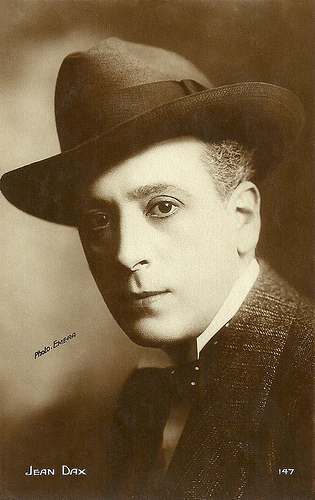
French postcard by Editions Cinémagazine, no. 147. Photo: Emera.
Burglar Under Her Bed
Jean Dax was born as Gontran Théodore Louis Henri Willar in Paris, France in 1879.
He made his film debut in 1909 and played that year in such short silent films as the Le Film d'Art productions Le luthier de Crémone/The Violin Maker of Cremona (André Calmettes, 1909) and L'Épi (André Calmettes, 1909) with Henry Krauss.
In the early 1910s, Dax often performed in films with music-hall star Mistinguett , as in L'épouvante/The Fright (Albert Capellani, 1911), in which Mistinguett plays herself, coming home and discovering a burglar under her bed.
Dax also co-acted often with leading actresses like Gabrielle Robinne . During the war of 1914-1918 he didn't act.
In 1919 Dax played in La Rafale/The gust (Jacques de Baroncelli, 1921), with Fannie Ward, the American actress from The Cheat (1915). It was the story of a gambler, who cheats his friends and kills himself despite his friend's attempts to save him.
In this period, Dax also played the lead in the Émile Zola adaptation L'assommoir/The bat (Maurice de Marsan, Charles Maudru, 1921).
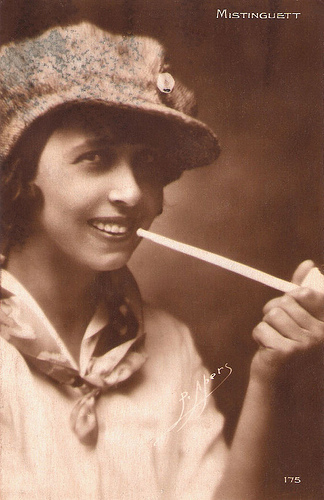
Mistinguett . French postcard by Cinémagazine-Edition, Paris, no. 175. Photo: P. Apers.
Memorable Roles
In the 1920s, Jean Dax continued his career on stage as a popular vaudeville actor, but he also became a French film star who also acted in films in Germany.
He played opposite Japanese star Sessue Hayakawa in La bataille/The Battle (Sessue Hayakawa, Édouard-Émile Violet, 1923) and opposite Chaplin's leading lady Edna Purviance in Education de prince/Education of a Prince (Henri Diamant-Berger, 1927).
Dax also played with stars of the German cinema: with Käthe von Nagy and Vivian Gibson in Die Durchgängerin/The Runaway Girl (Hanns Schwarz, 1928) and with Lil Dagover in Der geheime Kurier/The Secret Courier (Gennaro Righelli, 1928), an adaptation of Stendhal's Le rouge et le noir.
He also played opposite Italian actress Maria Jacobini and Czech actor Franz Lederer in Maman Colibri/Mother Hummingbird (Julien Duvivier, 1929).
When sound film arrived, Dax's parts became smaller. However, he still had memorable roles such as Talleyrand in the French version of Der Kongress tanzt: Le congrès s'amuse/The Congress Dances (Jean Boyer, Erik Charell, 1931) and the old emperor Franz Joseph in Anatole Litvak's historical drama Mayerling (1936) starring Charles Boyer and Danielle Darrieux .
Jean Dax quitted filming when war was at the verge of starting. He died in 1962 in Paris, nearly forgotten. He was 83 (Some sources say 82). Dax was divorced from singer Jeanne Sauvage.
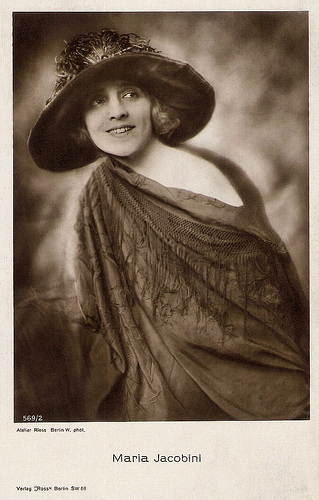
Maria Jacobini . German postcard by Ross Verlag, no. 569/2, 1919-1924. Atelier Riess, Berlin.
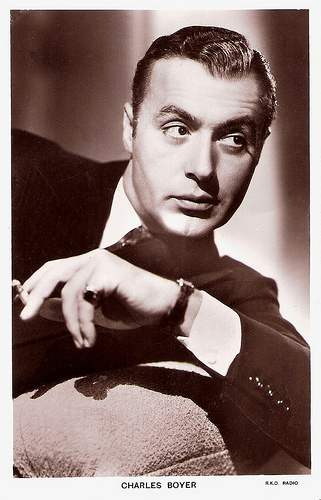
Charles Boyer . British postcard in the Picturegoer series, London, no. 1258. Photo: RKO Radio.
Sources: Philippe Pelletier (CinéArtistes - French), Wikipedia (French) and .

French postcard by Editions Cinémagazine, no. 147. Photo: Emera.
Burglar Under Her Bed
Jean Dax was born as Gontran Théodore Louis Henri Willar in Paris, France in 1879.
He made his film debut in 1909 and played that year in such short silent films as the Le Film d'Art productions Le luthier de Crémone/The Violin Maker of Cremona (André Calmettes, 1909) and L'Épi (André Calmettes, 1909) with Henry Krauss.
In the early 1910s, Dax often performed in films with music-hall star Mistinguett , as in L'épouvante/The Fright (Albert Capellani, 1911), in which Mistinguett plays herself, coming home and discovering a burglar under her bed.
Dax also co-acted often with leading actresses like Gabrielle Robinne . During the war of 1914-1918 he didn't act.
In 1919 Dax played in La Rafale/The gust (Jacques de Baroncelli, 1921), with Fannie Ward, the American actress from The Cheat (1915). It was the story of a gambler, who cheats his friends and kills himself despite his friend's attempts to save him.
In this period, Dax also played the lead in the Émile Zola adaptation L'assommoir/The bat (Maurice de Marsan, Charles Maudru, 1921).

Mistinguett . French postcard by Cinémagazine-Edition, Paris, no. 175. Photo: P. Apers.
Memorable Roles
In the 1920s, Jean Dax continued his career on stage as a popular vaudeville actor, but he also became a French film star who also acted in films in Germany.
He played opposite Japanese star Sessue Hayakawa in La bataille/The Battle (Sessue Hayakawa, Édouard-Émile Violet, 1923) and opposite Chaplin's leading lady Edna Purviance in Education de prince/Education of a Prince (Henri Diamant-Berger, 1927).
Dax also played with stars of the German cinema: with Käthe von Nagy and Vivian Gibson in Die Durchgängerin/The Runaway Girl (Hanns Schwarz, 1928) and with Lil Dagover in Der geheime Kurier/The Secret Courier (Gennaro Righelli, 1928), an adaptation of Stendhal's Le rouge et le noir.
He also played opposite Italian actress Maria Jacobini and Czech actor Franz Lederer in Maman Colibri/Mother Hummingbird (Julien Duvivier, 1929).
When sound film arrived, Dax's parts became smaller. However, he still had memorable roles such as Talleyrand in the French version of Der Kongress tanzt: Le congrès s'amuse/The Congress Dances (Jean Boyer, Erik Charell, 1931) and the old emperor Franz Joseph in Anatole Litvak's historical drama Mayerling (1936) starring Charles Boyer and Danielle Darrieux .
Jean Dax quitted filming when war was at the verge of starting. He died in 1962 in Paris, nearly forgotten. He was 83 (Some sources say 82). Dax was divorced from singer Jeanne Sauvage.

Maria Jacobini . German postcard by Ross Verlag, no. 569/2, 1919-1924. Atelier Riess, Berlin.

Charles Boyer . British postcard in the Picturegoer series, London, no. 1258. Photo: RKO Radio.
Sources: Philippe Pelletier (CinéArtistes - French), Wikipedia (French) and .
Published on November 01, 2015 22:00
October 31, 2015
Nora Gregor
Austrian Nora Gregor (1901-1949) was an operetta diva and a stage and film actress. Her most famous screen role was Christine de la Chesnaye in Jean Renoir's classic film La Règle du Jeu (1939). She worked briefly in Hollywood during the early talkie era, appearing in foreign-language versions of MGM productions.

German postcard by Ross Verlag, no. 5607/1, 1930-1931. Photo: Metro-Goldwyn-Mayer (MGM).
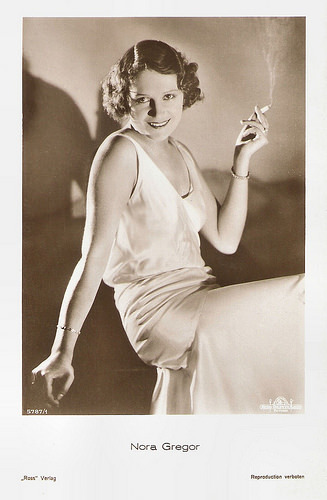
German postcard by Ross Verlag, no. 5787/1, 1930-1931. Photo: Metro-Goldwyn-Mayer.
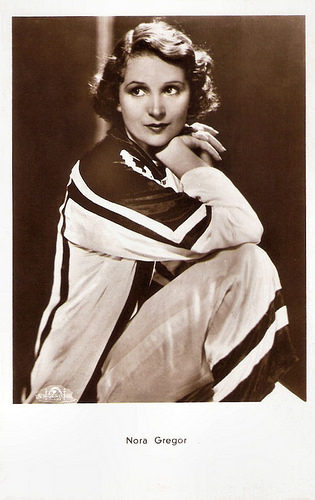
Austrian postcard by Iris Verlag, no. 6112. Distributed in Italy by Casa Editrice Ballerini & Fratini, Firenze. Photo: Metro-Goldwyn-Mayer.
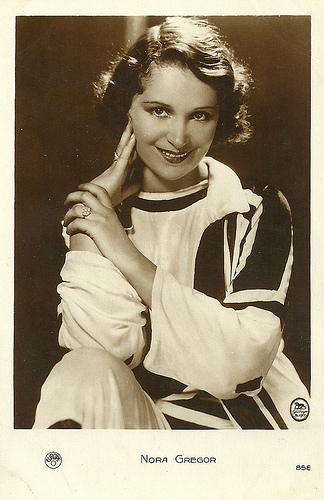
French postcard by Europe, no. 85E. Photo: Metro-Goldwyn-Mayer.
Groundbreaking film
Nora Gregor was born in 1901 as Eleonora Hermina Gregor in Görz (Gorizia) in former Austria-Hungary (now Italy) to Austrian Jewish parents.
She made her stage debut in an operetta in Graz, Austria. From there she went to the Volksbühne an das Raimund-Theater in Vienna. Her first silent film was Gefesselt/Tied Up (Peter Paul Felner, 1920). Other early Austrian films were Die Schauspielerin des Kaisers/The actress of the emperor (Hans Otto, 1921) and Meriota, die Tänzerin/Meriota, the Dancer (Julius Herska, 1921), in which she played Lucrezia Borgia. She continued her film career successfully with Die Venus/The Venus (Hans Homma, 1922) with Magda Sonja , and Die kleine Sünde/The Small Sin (Julius Herska, 1923).
With her role as the aristocratic femme fatale Princess Zamikoff in Michael/Chained: The Story of the Third Sex (1924), directed by Danish director Carl Theodor Dreyer, she achieved her first great success. This groundbreaking film tells the story of a bisexual love triangle with Benjamin Christensen and Walter Slezak as the other angles.
After this international breakthrough she appeared in such German productions as Das Mädchen mit dem Protektion/The girl with the patronage (Max Mack, 1925) with Ossi Oswalda , Der Geiger von Florenz/The violinist of Florence (Paul Czinner, 1926) with Elisabeth Bergner and Conrad Veidt , and Eheskandal im Hause Fromont jun. und Risler sen./Marriage scandal in the house Fromont jun. and Risler sen. (A.W. Sandberg, 1927) with Lucy Doraine .
MGM contracted Nora Gregor but while she arrived in Hollywood the talkie replaced the silent film. She had a short appearance in The Hollywood Revue of 1929 (Charles Reisner, 1929) and played the leading role in Olympia (Jacques Feyder, 1930), the German language version of His Glorious Night (Lionel Barrymore, 1930). She made a short excursion to Germany, where she starred with Harry Liedtke in Und das ist die Hauptsache/That's All That Matters (Joe May, 1931) and then she returned to Hollywood for more alternate language versions of MGM productions.
She appeared in Mordprozess Mary Dugan/The Trial of Mary Dugan (Arthur Robison, 1931) and together with Paul Morgan , Dita Parlo and Buster Keaton in Wir schalten um auf Hollywood/We switch over to Hollywood (Frank Reicher, 1931). She also played in the English spoken But the Flesh Is Weak (Jack Conway, 1932) with Robert Montgomery, based on a stage hit by Ivor Novello . Then she returned to Europe.
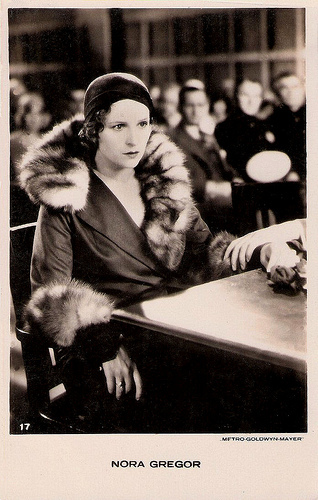
Dutch postcard, no. 17. Photo: Metro-Goldwyn-Mayer. Publicity still for Mordprozess Mary Dugan (Arthur Robison, 1931).
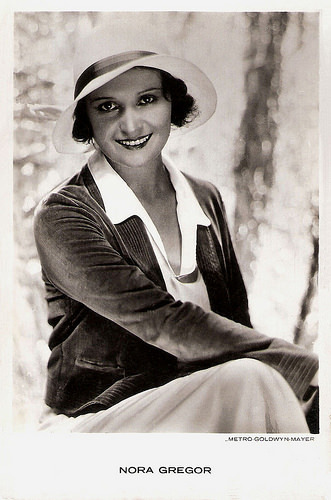
Dutch postcard. Sent by mail in 1932. Photo: Metro-Goldwyn-Mayer.
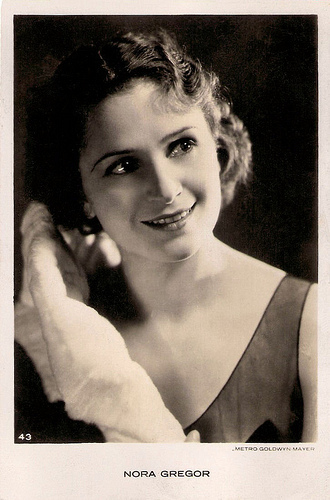
Dutch postcard by JosPé, Arnhem, no. 43. Photo: Metro-Goldwyn-Mayer.
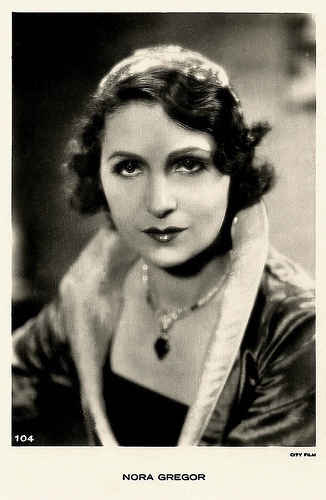
Dutch postcard by City Film, no. 104.
Eighty Family Estates
In Germany Nora Gregor played in Abenteuer am Lido/Adventure at the Lido (Richard Oswald, 1933) and opposite Peter Lorre in the entertaining comedy Was Frauen träumen/What Women Dream (Géza von Bolvary, 1933), based on a script by Billy Wilder. The next years she worked at the Max Reinhardt Bühne in Berlin and at the Burgtheater in Vienna, where she played Desdemona in Othello and Juliet in Romeo and Juliet by William Shakespeare.
In 1937, after divorcing pianist Mitja Nikisch, she married Prince Ernst Ruediger von Starhemberg, vice chancellor of Austria and nationalist and conservative politician. After the Anschluss by the Nazis in 1938, they had to flee from Austria and emigrated through Switzerland to France. There, her husband joined the Free French forces. Cut off from their money and the eighty family estates, they were supported for a period by Starhemberg's close friend Friedrich Mandl, the Austrian armaments magnate and former husband of Hedy Lamarr .
In France, Nora Gregor made only one film, the brilliant, black comedy La Règle du Jeu/The Rules of the Game (Jean Renoir, 1938). This controversial film was Renoir's look at bourgeois life in France at the onset of World War II. At Films de France, James Travers writes: "Although La Régle du jeu is now safely acknowledged as one of the greatest films in cinema history, it has certainly had a chequered history. The film was, at the time it was made, one of Renoir’s most ambitious films, costing around five million Francs, but it was a commercial disaster. (...) it was condemned by critics and public alike for its scandalous and depressing tone. Under the occupation during World War II, the film was banned, and soon disappeared into obscurity. The film resurfaced in the late 1950's, having been fully restored (under Renoir’s supervision), and following its showing at the Venice film festival in 1959 it was instantly established as one of the genuine masterpieces of world cinema."
This was to be Nora Gregor's last appearance in the European cinema. WW II forced her and her husband in 1942 to go in exile again and this time they went to Argentinia and Chile. Her last appearance was in the Chilean-French film La Fruta mordida/The Bitten Fruit (Jacques Rémy, 1945). Reportedly depressed since the beginning of her South American exile, she committed suicide in Viña del Mar, Chile (some sources say Santiago de Chile) in 1949. Her son Heinrich Starhemberg (1934-1997) was also an actor, often credited as Henry Gregor.
Scene from Michael/Chained: The Story of the Third Sex (1924). Source: RADIOSANTOS (YouTube).
Scene from Was Frauen träumen/What Women Dream (1933) with Peter Lorre and Nora Gregor.
Trailer of La Règle du Jeu/The Rules of the Game (1938). Source: Janusfilms (YouTube).
Sources: Thomas Staedeli, Hal Erickson (AllMovie), James Travers (Films de France), , Wikipedia, and .

German postcard by Ross Verlag, no. 5607/1, 1930-1931. Photo: Metro-Goldwyn-Mayer (MGM).

German postcard by Ross Verlag, no. 5787/1, 1930-1931. Photo: Metro-Goldwyn-Mayer.

Austrian postcard by Iris Verlag, no. 6112. Distributed in Italy by Casa Editrice Ballerini & Fratini, Firenze. Photo: Metro-Goldwyn-Mayer.

French postcard by Europe, no. 85E. Photo: Metro-Goldwyn-Mayer.
Groundbreaking film
Nora Gregor was born in 1901 as Eleonora Hermina Gregor in Görz (Gorizia) in former Austria-Hungary (now Italy) to Austrian Jewish parents.
She made her stage debut in an operetta in Graz, Austria. From there she went to the Volksbühne an das Raimund-Theater in Vienna. Her first silent film was Gefesselt/Tied Up (Peter Paul Felner, 1920). Other early Austrian films were Die Schauspielerin des Kaisers/The actress of the emperor (Hans Otto, 1921) and Meriota, die Tänzerin/Meriota, the Dancer (Julius Herska, 1921), in which she played Lucrezia Borgia. She continued her film career successfully with Die Venus/The Venus (Hans Homma, 1922) with Magda Sonja , and Die kleine Sünde/The Small Sin (Julius Herska, 1923).
With her role as the aristocratic femme fatale Princess Zamikoff in Michael/Chained: The Story of the Third Sex (1924), directed by Danish director Carl Theodor Dreyer, she achieved her first great success. This groundbreaking film tells the story of a bisexual love triangle with Benjamin Christensen and Walter Slezak as the other angles.
After this international breakthrough she appeared in such German productions as Das Mädchen mit dem Protektion/The girl with the patronage (Max Mack, 1925) with Ossi Oswalda , Der Geiger von Florenz/The violinist of Florence (Paul Czinner, 1926) with Elisabeth Bergner and Conrad Veidt , and Eheskandal im Hause Fromont jun. und Risler sen./Marriage scandal in the house Fromont jun. and Risler sen. (A.W. Sandberg, 1927) with Lucy Doraine .
MGM contracted Nora Gregor but while she arrived in Hollywood the talkie replaced the silent film. She had a short appearance in The Hollywood Revue of 1929 (Charles Reisner, 1929) and played the leading role in Olympia (Jacques Feyder, 1930), the German language version of His Glorious Night (Lionel Barrymore, 1930). She made a short excursion to Germany, where she starred with Harry Liedtke in Und das ist die Hauptsache/That's All That Matters (Joe May, 1931) and then she returned to Hollywood for more alternate language versions of MGM productions.
She appeared in Mordprozess Mary Dugan/The Trial of Mary Dugan (Arthur Robison, 1931) and together with Paul Morgan , Dita Parlo and Buster Keaton in Wir schalten um auf Hollywood/We switch over to Hollywood (Frank Reicher, 1931). She also played in the English spoken But the Flesh Is Weak (Jack Conway, 1932) with Robert Montgomery, based on a stage hit by Ivor Novello . Then she returned to Europe.

Dutch postcard, no. 17. Photo: Metro-Goldwyn-Mayer. Publicity still for Mordprozess Mary Dugan (Arthur Robison, 1931).

Dutch postcard. Sent by mail in 1932. Photo: Metro-Goldwyn-Mayer.

Dutch postcard by JosPé, Arnhem, no. 43. Photo: Metro-Goldwyn-Mayer.

Dutch postcard by City Film, no. 104.
Eighty Family Estates
In Germany Nora Gregor played in Abenteuer am Lido/Adventure at the Lido (Richard Oswald, 1933) and opposite Peter Lorre in the entertaining comedy Was Frauen träumen/What Women Dream (Géza von Bolvary, 1933), based on a script by Billy Wilder. The next years she worked at the Max Reinhardt Bühne in Berlin and at the Burgtheater in Vienna, where she played Desdemona in Othello and Juliet in Romeo and Juliet by William Shakespeare.
In 1937, after divorcing pianist Mitja Nikisch, she married Prince Ernst Ruediger von Starhemberg, vice chancellor of Austria and nationalist and conservative politician. After the Anschluss by the Nazis in 1938, they had to flee from Austria and emigrated through Switzerland to France. There, her husband joined the Free French forces. Cut off from their money and the eighty family estates, they were supported for a period by Starhemberg's close friend Friedrich Mandl, the Austrian armaments magnate and former husband of Hedy Lamarr .
In France, Nora Gregor made only one film, the brilliant, black comedy La Règle du Jeu/The Rules of the Game (Jean Renoir, 1938). This controversial film was Renoir's look at bourgeois life in France at the onset of World War II. At Films de France, James Travers writes: "Although La Régle du jeu is now safely acknowledged as one of the greatest films in cinema history, it has certainly had a chequered history. The film was, at the time it was made, one of Renoir’s most ambitious films, costing around five million Francs, but it was a commercial disaster. (...) it was condemned by critics and public alike for its scandalous and depressing tone. Under the occupation during World War II, the film was banned, and soon disappeared into obscurity. The film resurfaced in the late 1950's, having been fully restored (under Renoir’s supervision), and following its showing at the Venice film festival in 1959 it was instantly established as one of the genuine masterpieces of world cinema."
This was to be Nora Gregor's last appearance in the European cinema. WW II forced her and her husband in 1942 to go in exile again and this time they went to Argentinia and Chile. Her last appearance was in the Chilean-French film La Fruta mordida/The Bitten Fruit (Jacques Rémy, 1945). Reportedly depressed since the beginning of her South American exile, she committed suicide in Viña del Mar, Chile (some sources say Santiago de Chile) in 1949. Her son Heinrich Starhemberg (1934-1997) was also an actor, often credited as Henry Gregor.
Scene from Michael/Chained: The Story of the Third Sex (1924). Source: RADIOSANTOS (YouTube).
Scene from Was Frauen träumen/What Women Dream (1933) with Peter Lorre and Nora Gregor.
Trailer of La Règle du Jeu/The Rules of the Game (1938). Source: Janusfilms (YouTube).
Sources: Thomas Staedeli, Hal Erickson (AllMovie), James Travers (Films de France), , Wikipedia, and .
Published on October 31, 2015 23:00
October 30, 2015
Imported from the USA: Maria Montez
Dominican film actress María Montez (1912-1951) gained fame and popularity as a tempestuous Latino beauty in Hollywood movies of the 1940s. In a series of exotic adventures filmed in Technicolor, she starred as Arabian princesses, jungle goddesses and highborn gypsies, dressed in fanciful costumes and sparkling jewels. Over her career, ‘The Queen of Technicolor’ appeared in 26 films, of which five were made in Europe.
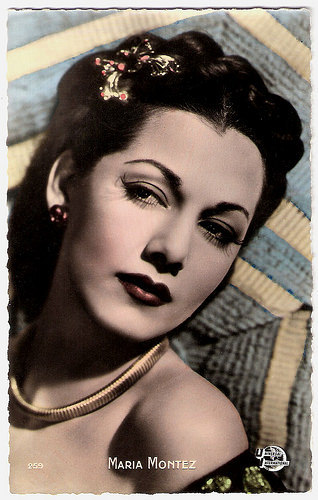
French postcard by Editions P.I., no. 259. Photo: Universal International.
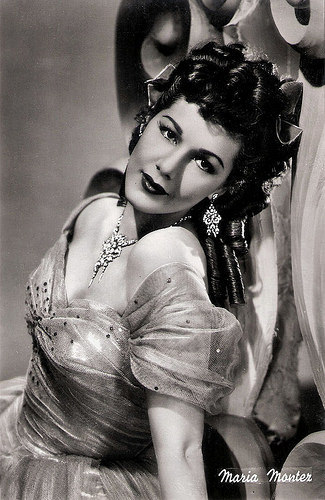
Italian postcard by Rotophot, Milano, no. 14.
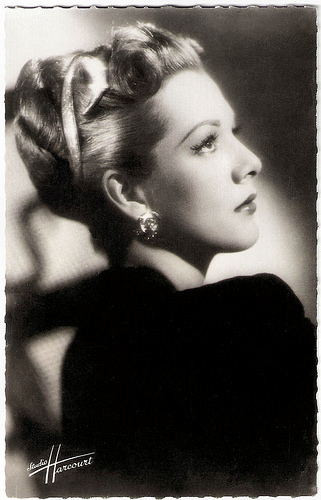
French postcard by Editions O.P., Paris, no. 28. Photo: Studio Harcourt.
The Caribbean Cyclone
Maria Montez was born Maria Africa Gracia Vidal in Barahona, Dominican Republic in 1912. She was one of ten children born to Isidoro Gracía, and his wife Teresa Vidal. Her father was a textile exporter and the Honorary Vice Consul of Spain in the Dominican Republic. Despite what several sources write, Montez lived the first 27 years of her life in the Dominican Republic.
In 1932 she married William G. McFeeters, a wealthy banker who served in the British army. In 1939 they divorced and Maria moved to New York City, where she worked as a model. She was discovered by a Universal talent scout and left for Hollywood.
One of her first films for Universal was the Science Fiction comedy The Invisible Woman (A. Edward Sutherland, 1940) in which she had a bit part as a model. In the B-Western Boss of Bullion City (Ray Taylor, 1940) starring Johnny Mack Brown, Montez was the female lead. It was the first time she played a leading role and was the only one of her film roles where she speaks some Spanish. South of Tahiti (George Waggner, 1941) with Brian Donlevy and Broderick Crawford, helped to launch her as a pin-up star.
Her beauty soon made her the centrepiece of Universal's Technicolor costume adventures. Her most frequent costar was Jon Hall, who some critics claimed was even prettier and better built than she was. Their joint films were the big hit Arabian Nights (John Rawlins, 1942) with Sabu , White Savage (Arthur Lubin, 1943), Ali Baba and the Forty Thieves (Arthur Lubin, 1944) with Turhan Bey, the camp classic Cobra Woman (Robert Siodmak, 1944), Gypsy Wildcat (Roy William Neil, 1944), and Sudan (John Rawlins, 1945).
Hal Erickson at AllMovie : “A 24-hour-a-day star, Ms. Montez was famous for her spectacular entrances at nightclubs and social functions; once, when her arrival at the Universal commissary failed to attract notice, she turned her heel and left the room, returning moments later with a huge entourage and accompanying loud noises.”
‘The Caribbean Cyclone’ often quarrelled with her directors and went on suspension for refusing the lead in the Western Frontier Gal (Charles Lamont, 1945). Her role was taken by Yvonne de Carlo who had become a similar sort of star and began to supplant Montez's position at the studio. Montez then appeared in the sepia-toned swashbuckler The Exile (Max Ophüls, 1947) starring Douglas Fairbanks, Jr., and the Technicolor Western Pirates of Monterey (Alfred L. Werker, 1947) with Rod Cameron. It was to be her last film for Universal.
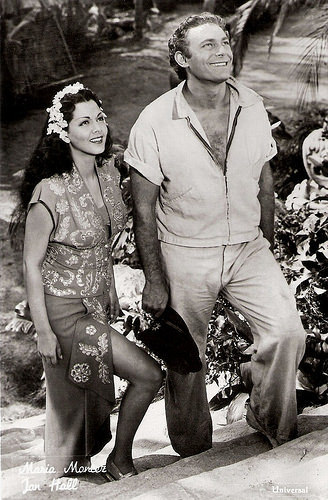
Maria Montez and Jon Hall in White Savage (1943). Vintage card. Photo: Universal. Publicity still for White Savage (Arthur Lubin, 1943).
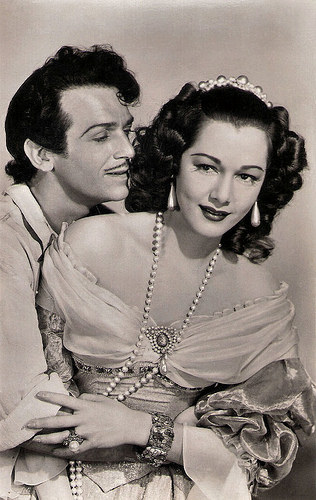
Maria Montez and Douglas Fairbanks Jr. in The Exile (1947). Spanish postcard by Sobe, no. 452. Photo: publicity still for The Exile (Max Ophüls, 1947).

Maria Montez and Jean-Pierre Aumont . Dutch postcard, no. 3117. Photo: Universal International.
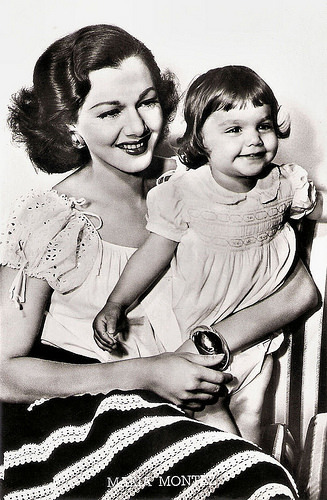
Maria Montez and Tina Aumont . Vintage postcard, no. 301.
Sadistic manager of a circus show
While working in Hollywood, Maria Montez met French actor Jean-Pierre Aumont . They married in 1943 at Montez's home in Beverly Hills. Aumont had to leave a few days after their wedding to serve in the Free French Forces fighting against Nazi Germany during World War II. At the end of the war, the couple had a daughter, Maria Christina (also known as actress Tina Aumont ), born in Hollywood in 1946.
The couple starred together in the American adventure film Siren of Altantis (Gregg G. Tallas, 1949), produced by United Artists. It was the first movie Montez made after leaving Universal Pictures. By then, her career in the United States began to wane due to audiences' changing taste in films.
Montez and Aumont, then moved to a home in Suresnes, a western suburb of Paris. In France, Montez appeared in several films and the play L'Ile Heureuse (The happy island), written by her husband. Her first French film was Hans le marin/Wicked City (François Villiers, 1949) with Jean-Pierre Aumont and Lilli Palmer. It was a success in Europe.
She then played the sadistic manager of a circus show, who uses her attractiveness to seduce men and force them to do dangerous acrobatic acts in Portrait d'un assassin/Portrait of an Assassin (Bernard-Roland, 1949). One of her victims was played by Erich von Stroheim .
She also wrote three books, two of which were published, as well as penning a number of poems. In Italy, she starred in the Italian-American coproduction Il Ladro di Venezia/The Thief of Venice (John Brahm, 1950) with another former Universal contract star, Paul Christian a.k.a. Paul Hubschmid . Her last film was the Italian adventure film La vendetta del corsaro/Revenge of the Pirates (Primo Zeglio, 1951).
At only 39, Maria Montez died in Suresnes, France in 1951 after apparently suffering a heart attack and drowning in her bath. She was buried in the Cimetière du Montparnasse in Paris where her tombstone gives her amended year of birth (1918), not the actual year of birth (1912). Shortly after her death, a street in the city of Barahona, Montez's birthplace, was named after her. In 1996, the city of Barahona opened the Aeropuerto Internacional María Montez (María Montez International Airport) in her honour.
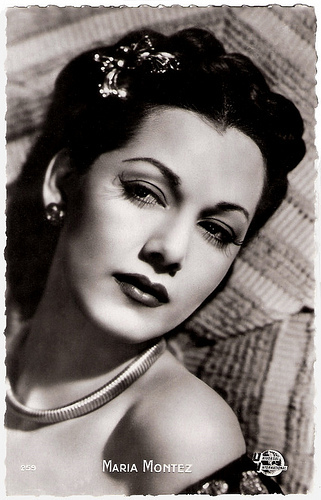
French postcard by Editions P.I., no. 259. Photo: Universal International.
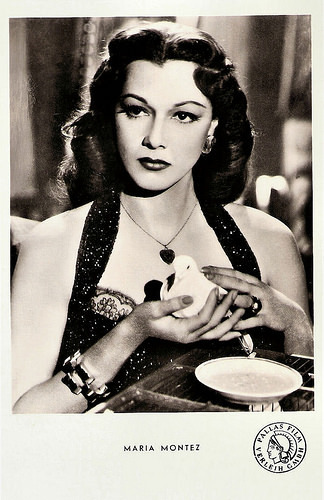
German postcard by Kunst und Bild, Berlin, no. A 292. Photo: Pallas Film Verleih.
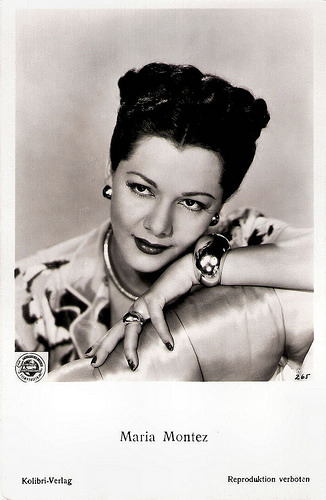
German postcard by Kolibri-Verlag. Photo: Universal International.
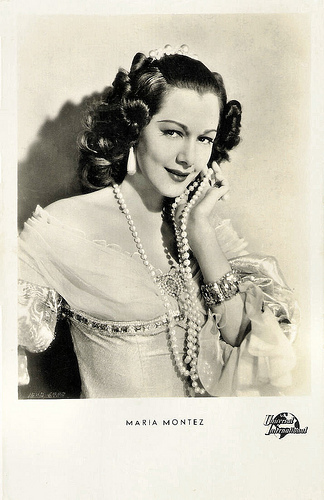
German postcard by Kunst und Bild, Berlin, no. A 556. Photo: Universal International. Photo: publicity still for The Exile (Max Ophüls, 1947).
Sources: Hal Erickson (AllMovie), (IMDb), Wikipedia and .

French postcard by Editions P.I., no. 259. Photo: Universal International.

Italian postcard by Rotophot, Milano, no. 14.

French postcard by Editions O.P., Paris, no. 28. Photo: Studio Harcourt.
The Caribbean Cyclone
Maria Montez was born Maria Africa Gracia Vidal in Barahona, Dominican Republic in 1912. She was one of ten children born to Isidoro Gracía, and his wife Teresa Vidal. Her father was a textile exporter and the Honorary Vice Consul of Spain in the Dominican Republic. Despite what several sources write, Montez lived the first 27 years of her life in the Dominican Republic.
In 1932 she married William G. McFeeters, a wealthy banker who served in the British army. In 1939 they divorced and Maria moved to New York City, where she worked as a model. She was discovered by a Universal talent scout and left for Hollywood.
One of her first films for Universal was the Science Fiction comedy The Invisible Woman (A. Edward Sutherland, 1940) in which she had a bit part as a model. In the B-Western Boss of Bullion City (Ray Taylor, 1940) starring Johnny Mack Brown, Montez was the female lead. It was the first time she played a leading role and was the only one of her film roles where she speaks some Spanish. South of Tahiti (George Waggner, 1941) with Brian Donlevy and Broderick Crawford, helped to launch her as a pin-up star.
Her beauty soon made her the centrepiece of Universal's Technicolor costume adventures. Her most frequent costar was Jon Hall, who some critics claimed was even prettier and better built than she was. Their joint films were the big hit Arabian Nights (John Rawlins, 1942) with Sabu , White Savage (Arthur Lubin, 1943), Ali Baba and the Forty Thieves (Arthur Lubin, 1944) with Turhan Bey, the camp classic Cobra Woman (Robert Siodmak, 1944), Gypsy Wildcat (Roy William Neil, 1944), and Sudan (John Rawlins, 1945).
Hal Erickson at AllMovie : “A 24-hour-a-day star, Ms. Montez was famous for her spectacular entrances at nightclubs and social functions; once, when her arrival at the Universal commissary failed to attract notice, she turned her heel and left the room, returning moments later with a huge entourage and accompanying loud noises.”
‘The Caribbean Cyclone’ often quarrelled with her directors and went on suspension for refusing the lead in the Western Frontier Gal (Charles Lamont, 1945). Her role was taken by Yvonne de Carlo who had become a similar sort of star and began to supplant Montez's position at the studio. Montez then appeared in the sepia-toned swashbuckler The Exile (Max Ophüls, 1947) starring Douglas Fairbanks, Jr., and the Technicolor Western Pirates of Monterey (Alfred L. Werker, 1947) with Rod Cameron. It was to be her last film for Universal.

Maria Montez and Jon Hall in White Savage (1943). Vintage card. Photo: Universal. Publicity still for White Savage (Arthur Lubin, 1943).

Maria Montez and Douglas Fairbanks Jr. in The Exile (1947). Spanish postcard by Sobe, no. 452. Photo: publicity still for The Exile (Max Ophüls, 1947).

Maria Montez and Jean-Pierre Aumont . Dutch postcard, no. 3117. Photo: Universal International.

Maria Montez and Tina Aumont . Vintage postcard, no. 301.
Sadistic manager of a circus show
While working in Hollywood, Maria Montez met French actor Jean-Pierre Aumont . They married in 1943 at Montez's home in Beverly Hills. Aumont had to leave a few days after their wedding to serve in the Free French Forces fighting against Nazi Germany during World War II. At the end of the war, the couple had a daughter, Maria Christina (also known as actress Tina Aumont ), born in Hollywood in 1946.
The couple starred together in the American adventure film Siren of Altantis (Gregg G. Tallas, 1949), produced by United Artists. It was the first movie Montez made after leaving Universal Pictures. By then, her career in the United States began to wane due to audiences' changing taste in films.
Montez and Aumont, then moved to a home in Suresnes, a western suburb of Paris. In France, Montez appeared in several films and the play L'Ile Heureuse (The happy island), written by her husband. Her first French film was Hans le marin/Wicked City (François Villiers, 1949) with Jean-Pierre Aumont and Lilli Palmer. It was a success in Europe.
She then played the sadistic manager of a circus show, who uses her attractiveness to seduce men and force them to do dangerous acrobatic acts in Portrait d'un assassin/Portrait of an Assassin (Bernard-Roland, 1949). One of her victims was played by Erich von Stroheim .
She also wrote three books, two of which were published, as well as penning a number of poems. In Italy, she starred in the Italian-American coproduction Il Ladro di Venezia/The Thief of Venice (John Brahm, 1950) with another former Universal contract star, Paul Christian a.k.a. Paul Hubschmid . Her last film was the Italian adventure film La vendetta del corsaro/Revenge of the Pirates (Primo Zeglio, 1951).
At only 39, Maria Montez died in Suresnes, France in 1951 after apparently suffering a heart attack and drowning in her bath. She was buried in the Cimetière du Montparnasse in Paris where her tombstone gives her amended year of birth (1918), not the actual year of birth (1912). Shortly after her death, a street in the city of Barahona, Montez's birthplace, was named after her. In 1996, the city of Barahona opened the Aeropuerto Internacional María Montez (María Montez International Airport) in her honour.

French postcard by Editions P.I., no. 259. Photo: Universal International.

German postcard by Kunst und Bild, Berlin, no. A 292. Photo: Pallas Film Verleih.

German postcard by Kolibri-Verlag. Photo: Universal International.

German postcard by Kunst und Bild, Berlin, no. A 556. Photo: Universal International. Photo: publicity still for The Exile (Max Ophüls, 1947).
Sources: Hal Erickson (AllMovie), (IMDb), Wikipedia and .
Published on October 30, 2015 23:00
October 29, 2015
EFSP's Dazzling Dozen: Boys Will Be Boys
During our trip to the Pordenone Silent Film Festival earlier this month, we did a post on twelve silent cowboys. We liked the concept. So we started a new series especially for Postcard Friendship Friday: a dozen postcards with a theme. This Friday and the next it is postcards of child stars. The following week twelve little girls who provided keen and tough competition to Shirley Temple. Today, postcards from different countries and different times which all confirm that boys will be boys....
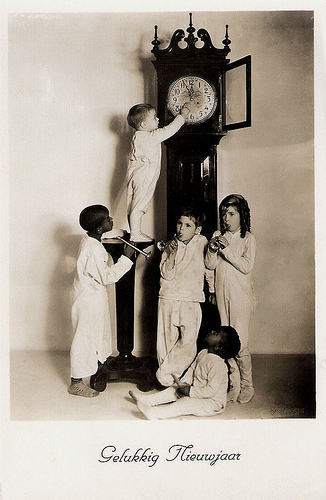
Our Gang . Dutch postcard. Caption: "Gelukkig Nieuwjaar" (Happy New Year).
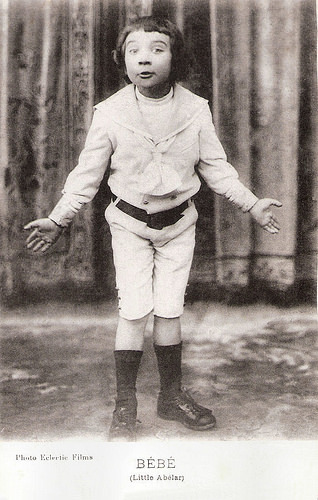
French postcard. Photo Eclectic Films.
Clément Mary (1905-1974) was as Bébé the best known child actor of the early 1910s. He would later act in French sound films as René Dary.
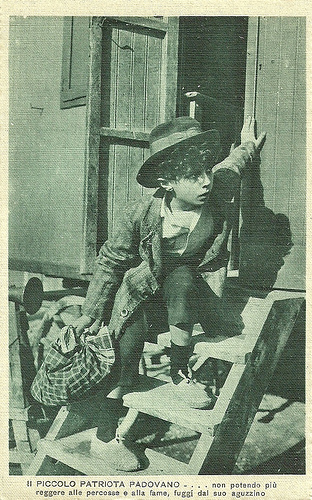
Italian postcard, no. 3373. Photo: Film Artistica Gloria, Torino. Ermanno Roveri in Il piccolo patriota padovano (Leopoldo Carlucci Gloria 1915). Caption: No longer able to stand the beatings and the hunger, he escapes his tormentor.
Italian actor Ermanno Roveri (1903-1968) started his career as child star, a.o. in various adaptations of the stories from Cuore, such as Dagli Appennini alle Ande, Naufragio, Il piccolo patriota padovano and Il piccolo scrivano fiorentino, all filmed in 1915-1916 for the company Gloria Film.
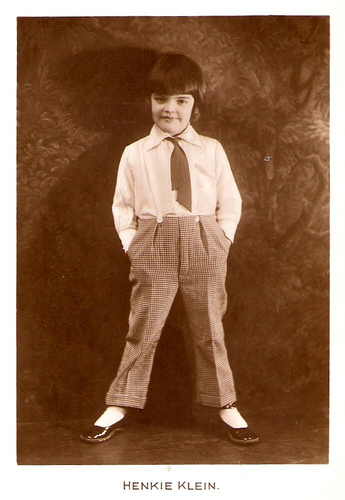
Dutch postcard by B. Brouwer, Amsterdam. Photo: Bernard Eilers, Amsterdam.
Little Henkie Klein (1921-?) was a child actor in German and Dutch films of the silent era. He was called the 'Dutch Jackie Coogan'.
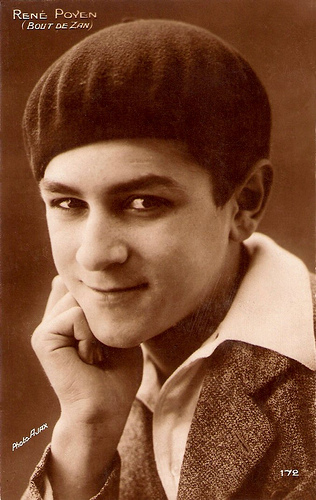
French postcard. Photo Ajax, no. 172.
René Poyen (1908-1968) was a famous child star in silent French cinema, who started at the age of four as the popular character Bout-de-Zan at the Gaumont film company. Most of his burlesque comedies were filmed by Louis Feuillade.
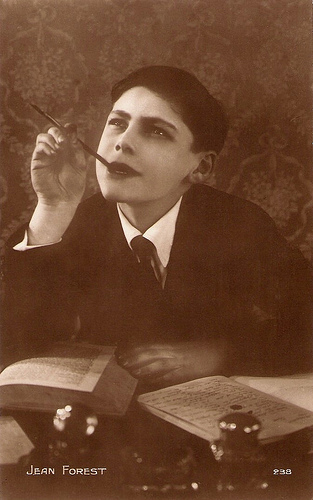
French postcard by Cinémagazine, no. 238.
Jean Forest (1912-1980) is best remembered for his touching, naturalist and convincing performances as boy actor in the silent French films by Jacques Feyder: Crainquebille (1922), Visages d'enfants (1923-1925) and Gribiche (1926).
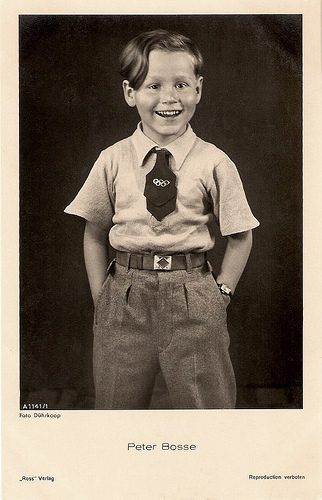
German Postcard by Ross Verlag, no. A1276/1. 1937-1938. Photo: Manassée-Ricoll, Wien / Mondial.
Actor, presenter and journalist Peter Bosse (1931) was a popular child star of the German cinema in the 1930s. The boy with his cheeky face made 28 films.
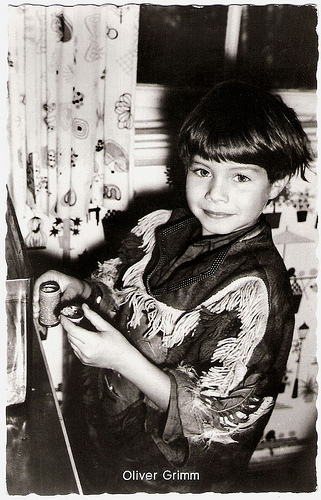
German postcard by Kolibri-Verlag G.m.b.H., Minden/Westf., no. 2000. Photo: H. / Fü.
Oliver Grimm (1948) was Germany's favourite child star for more than a decade, He made 17 films between 1952 and 1963.
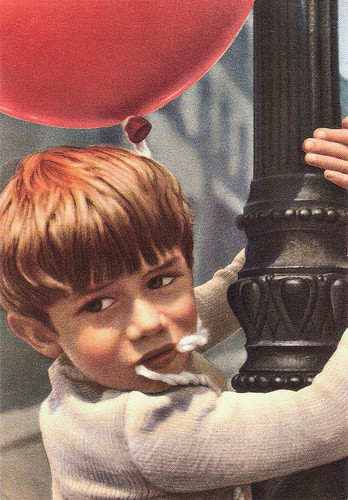
Italian postcard in the series Piccoli uomini nel cinema by Ed. Villaggio del Fanciullo, Bologna. Photo: Cino del Duca. Publicity still for Le ballon rouge/The red balloon (Albert Lamorisse, 1956).
French child actor Pascal Lamorisse (1950) is known by film lovers all over the world because of his parts in the short films Crin blanc: Le cheval sauvage (1953) and Le ballon rouge (1956), both directed by his father, Albert Lamorisse.

Italian postcard by Ed. Villaggio del Fanciullo, Bologna. Photo: E.N.I.C. Publicity still for Marcelino, pan y vino/Marcelino Bread And Wine (1955).
Pablito Calvo (1948–2000) was a Spanish child actor. After the international success of Marcelino, pan y vino/Marcelino Bread And Wine (1955), he became a star. At the age of 16, he retired.
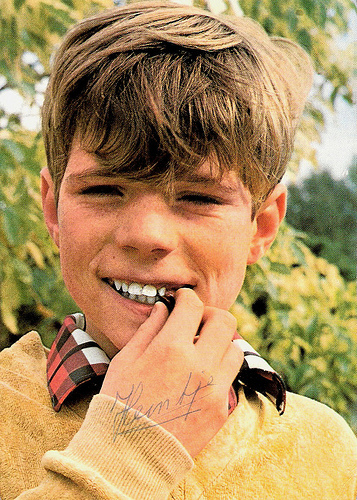
German promotion card by Ariola, no. Ar 108. Photo: Norbert Unfried.
Dutch singer and actor Hein Simons (1955) was a famous child star in the 1960s under the name Heintje . He sang in Dutch, English, German, Japanese and Afrikaans, and he sold more than 40 million records worldwide. His greatest hit was Mama. Between 1968 and 1971 he also starred in six German light entertainment films, of which one became surprisingly popular in Red China.
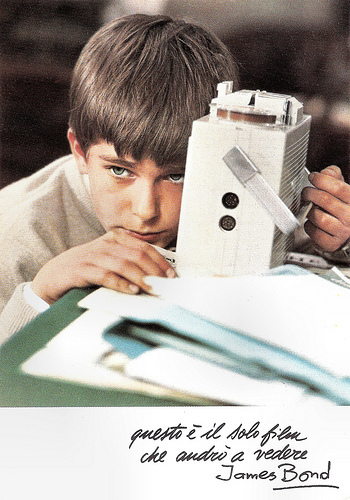
Italian postcard. Photo: publicity still for Incompreso/Misunderstood (Luigi Comencini, 1966) with Stefano Colagrande . Caption: "Questo è il solo film che andro a vedere. James Bond" (This is the only movie I'll go to see. James Bond). This sweet and sad film is also a personal favourite of EFSP's editor-in-chief a.k.a. 008.
This is a post for Postcard Friendship Friday, hosted by Beth at the The Best Hearts are Crunchy. You can visit her by clicking on the button below.


Our Gang . Dutch postcard. Caption: "Gelukkig Nieuwjaar" (Happy New Year).

French postcard. Photo Eclectic Films.
Clément Mary (1905-1974) was as Bébé the best known child actor of the early 1910s. He would later act in French sound films as René Dary.

Italian postcard, no. 3373. Photo: Film Artistica Gloria, Torino. Ermanno Roveri in Il piccolo patriota padovano (Leopoldo Carlucci Gloria 1915). Caption: No longer able to stand the beatings and the hunger, he escapes his tormentor.
Italian actor Ermanno Roveri (1903-1968) started his career as child star, a.o. in various adaptations of the stories from Cuore, such as Dagli Appennini alle Ande, Naufragio, Il piccolo patriota padovano and Il piccolo scrivano fiorentino, all filmed in 1915-1916 for the company Gloria Film.

Dutch postcard by B. Brouwer, Amsterdam. Photo: Bernard Eilers, Amsterdam.
Little Henkie Klein (1921-?) was a child actor in German and Dutch films of the silent era. He was called the 'Dutch Jackie Coogan'.

French postcard. Photo Ajax, no. 172.
René Poyen (1908-1968) was a famous child star in silent French cinema, who started at the age of four as the popular character Bout-de-Zan at the Gaumont film company. Most of his burlesque comedies were filmed by Louis Feuillade.

French postcard by Cinémagazine, no. 238.
Jean Forest (1912-1980) is best remembered for his touching, naturalist and convincing performances as boy actor in the silent French films by Jacques Feyder: Crainquebille (1922), Visages d'enfants (1923-1925) and Gribiche (1926).

German Postcard by Ross Verlag, no. A1276/1. 1937-1938. Photo: Manassée-Ricoll, Wien / Mondial.
Actor, presenter and journalist Peter Bosse (1931) was a popular child star of the German cinema in the 1930s. The boy with his cheeky face made 28 films.

German postcard by Kolibri-Verlag G.m.b.H., Minden/Westf., no. 2000. Photo: H. / Fü.
Oliver Grimm (1948) was Germany's favourite child star for more than a decade, He made 17 films between 1952 and 1963.

Italian postcard in the series Piccoli uomini nel cinema by Ed. Villaggio del Fanciullo, Bologna. Photo: Cino del Duca. Publicity still for Le ballon rouge/The red balloon (Albert Lamorisse, 1956).
French child actor Pascal Lamorisse (1950) is known by film lovers all over the world because of his parts in the short films Crin blanc: Le cheval sauvage (1953) and Le ballon rouge (1956), both directed by his father, Albert Lamorisse.

Italian postcard by Ed. Villaggio del Fanciullo, Bologna. Photo: E.N.I.C. Publicity still for Marcelino, pan y vino/Marcelino Bread And Wine (1955).
Pablito Calvo (1948–2000) was a Spanish child actor. After the international success of Marcelino, pan y vino/Marcelino Bread And Wine (1955), he became a star. At the age of 16, he retired.

German promotion card by Ariola, no. Ar 108. Photo: Norbert Unfried.
Dutch singer and actor Hein Simons (1955) was a famous child star in the 1960s under the name Heintje . He sang in Dutch, English, German, Japanese and Afrikaans, and he sold more than 40 million records worldwide. His greatest hit was Mama. Between 1968 and 1971 he also starred in six German light entertainment films, of which one became surprisingly popular in Red China.

Italian postcard. Photo: publicity still for Incompreso/Misunderstood (Luigi Comencini, 1966) with Stefano Colagrande . Caption: "Questo è il solo film che andro a vedere. James Bond" (This is the only movie I'll go to see. James Bond). This sweet and sad film is also a personal favourite of EFSP's editor-in-chief a.k.a. 008.
This is a post for Postcard Friendship Friday, hosted by Beth at the The Best Hearts are Crunchy. You can visit her by clicking on the button below.

Published on October 29, 2015 23:00
October 28, 2015
Mary Kid
Mary Kid (1901-1988) was a popular actress of the Austrian and German silent cinema. She also played in two early sound films in Italy.
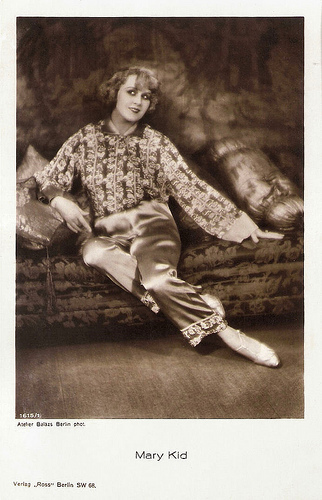
German postcard by Ross Verlag, Berlin, no. 1615/1, 1927-1928. Photo: Atelier Bálazs, Berlin.
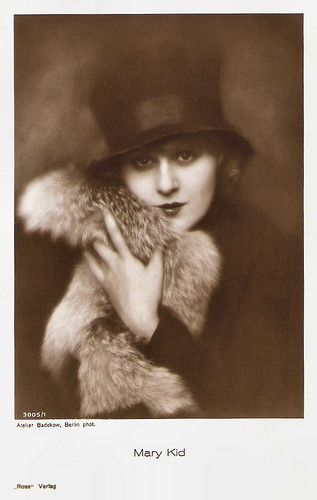
German postcard by Ross Verlag, Berlin, no. 3005/1, 1928-1929. Photo: Atelier Badekow, Berlin.
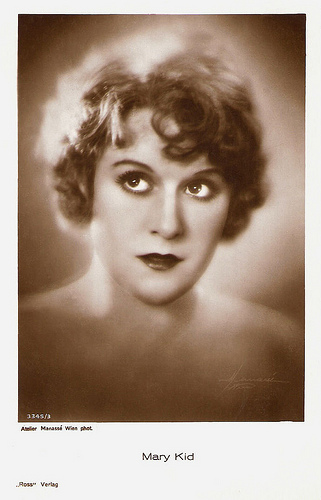
German postcard by Ross Verlag, no. 3345/3, 1928-1929. Photo: Atelier Manassé, Vienna.
Lured by a Count
Mary Kid was born as Marie Anna Albertine Keul in Hamburg, Germany in 1901 ( IMDb wrongly states 1904). Mary took theatre lessons in her hometown Hamburg, but before she could start a stage career there, the Austrian film producer Count Sascha Kolowrat took her to Vienna to turn her into a film star.
For Sacha Film she played in three films directed by Mihaly Kertesz (the future Michael Curtiz): Namenlos/Der falsche Arzt/Nameless (1923), Die Lawine/The avalanche (1923), and Harun al Raschid (1923-1924) – in which she had the female lead.
In 1924 Kid returned to Germany and continued her film career in Berlin, performing in around 25 films between 1924 and 1930. Her first German film was the comedy of morals Lumpen und Seide/Rags and Silk (Richard Oswald, 1924 in which she played opposite Reinhold Schünzel , Mary Parker and Johannes Riemann .
This was followed by more Richard Oswald films: Halbseide/Half-silk (1925), Vorderhaus und Hinterhaus/Front building and house at the back (1925) - both again with Mary Parker , Wir sind vom K.u.K. Infanterieregiment/We are from the K.u.K. Infantry regiment (1926), in which Kid had the female lead as Lily opposite Paul Heidemann , and Lützows wilde verwegene Jagd/Lützows wild bold hunt (1926-1927), a film set in Napoleon’s times in which Kid starred as an actress from the Viennese Burgtheater.
Mary Kid had more major roles in Sumpf und Moral/Marsh and morality (Rudolf Walther-Fein, 1924) with Wilhelm Dieterle , Der Bastard/The Bastard (Gennaro Righelli, 1925) with Maria Jacobini , Zirkus Renz/Circus Renz (Wolfgang Neff, 1926), Heimliche Sünder (Franz Seitz sen., 1926), Ich war zu Heidelberg Student/I Was a Student at Heidelberg (Wolfgang Neff, 1926) – in which Kid had the female lead, Die Tochter des Kunstreiters/The daughter of the Circus Rider (Siegfried Philippi, 1927), and Die Geliebte seiner Hoheit/The Lover of His Highness (Jakob & Luisa Fleck, 1927).
In Song/Schmutziges Geld (Richard Eichberg, 1928), Mary Kid played the evil antagonist Gloria who pushes knife thrower Jack ( Heinrich George ) to rob for her. When Jack is blinded because of the robbery Jack’s new friend Song ( Anna May Wong ) helps him out, pretending to be Gloria, but she pays for the disguise. She also appeared in Dornenweg einer Fürstin/Rasputin (Nikolaj Larin, 1928) in which Gregori Chmara played the notorious Russian monk.
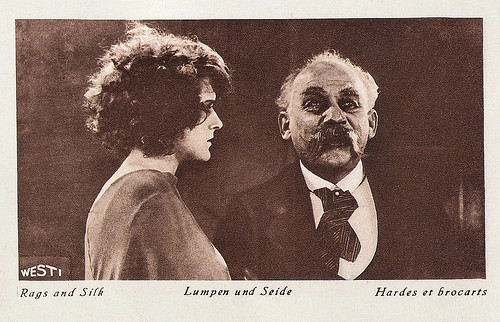
German postcard. Photo: Westi, Berlin. Publicity still for Lumpen und Seide/Rags and Silk (Richard Oswald, 1925) with Ferdinand Bonn.
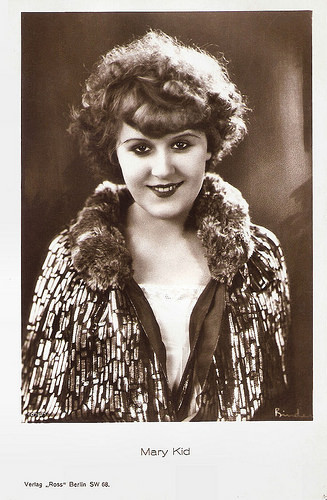
German postcard by Ross Verlag, no. 1076/1, 1927-1928. Photo: Alex Binder, Berlin.
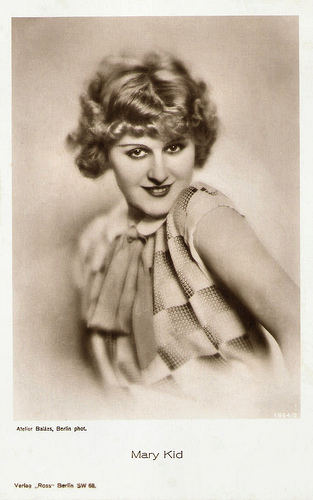
German postcard by Ross Verlag, no. 1864/2, 1927-1928. Photo: Atelier Balázs, Berlin.
Between Vienna and Berlin
Then Mary Kid returned to Vienna. During the last years of the silent era she did various films there. In 1928 she starred in Die verschwundene Frau/The Woman Who Disappeared (Karl Hans Leiter, 1928) with Harry Halm and a young Peter Lorre , Die beiden Seehunde/The Two Seals (Max Neufeld, 1928) with Werner Pittschau, and Andere Frauen/Other Women (Heinz Hanus, 1928) with Rina De Liguoro .
In 1929 Mary Kid went back to Berlin to play in Die süsse Yvonne/Sweet Yvonne (Max Reichmann, 1929), in which Kid had the female lead opposite Fritz Schulz , and Der Leutnant ihrer Majestät/The Lieutenant of Her Majesty (Jakob & Luisa Fleck, 1929) starring Agnes Esterhazy as the Empress.
In Berlin, she also appeared in the First World War drama Die Herrin und ihre Knecht/The Boss and Her Servant (1929). Henny Porten stars as a German landlady who is helped by a Russian officer ( Igo Sym ) despite war time, but is afraid he will choose her younger sister (Kid). She then must choose between love and patriotism. The film was directed by Kid’s old acquaintance Richard Oswald.
In 1930 Kid returned again to Vienna where she played in her last three silent films: General Babka (1930), directed by Hungarian director Desider/Deszö Kertesz, starring Wolf Albach-Retty , Eine Dirne ist ermordet worden/A prostitute has been murdered (Conrad Wiene, 1930), and Der Onkel aus Sumatra/The Uncle from Sumatra (Julius Szöreghy, 1930).
In 1931 Kid went to Italy where she played in her only two sound films. The first was Rubacuori/Heartbreaker (Guido Brignone, 1931), a comedy about an old Casanova ( Armando Falconi ) who hunts young women until his wife (Tina Lattanzi) finds a jewel that belongs to one of his girl friends. Falconi’s character comes between a prize fighter (Egon Stief) and his wife (Mary Kid).
Kid's second Italian film was Kennst Du das Land/Saltarello (Constantin J. David, 1931). Though produced by the Italian companies Pittaluga and Cines and shot by an Italian crew, the cast was German-Austrian. It was an alternative language version of Terra madre/Mother Earth (Alessandro Blasetti, 1931) starring Leda Gloria.
After that, Mary Kid withdrew to her birthtown Hamburg. There she died nearly sixty years later in 1988.
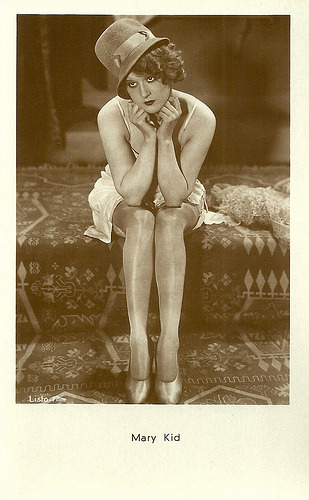
This is probably an Austrian postcard. Listo-Film was an Austrian film company. As no Listo-Film production with Kid is known at IMDb , Listo-Film may have been used as Austrian distributor for one of Kid's German films.
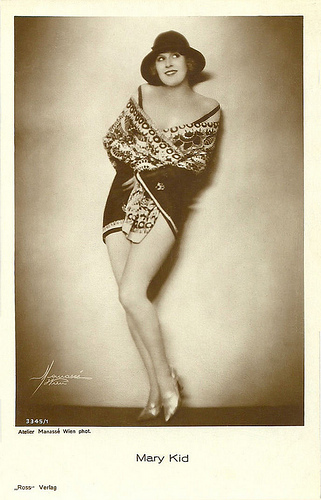
German postcard by Ross Verlag, no. 3345/1, 1928-1929. Photo: Atelier Manassé, Vienna. Collection: Didier Hanson.
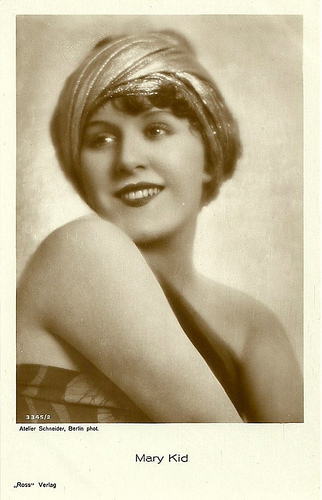
German postcard by Ross Verlag, no. 3345/2, 1928-1929. Photo: Atelier Schneider, Berlin.
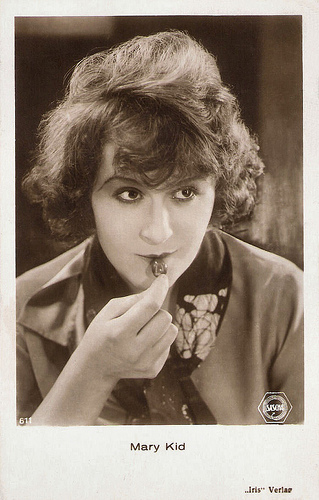
Austrian postcard by Iris Verlag, no. 611. Sent by mail in 1932. Photo: Sascha.
Sources: Thomas Staedeli (Cyranos), Wikipedia (German), and .

German postcard by Ross Verlag, Berlin, no. 1615/1, 1927-1928. Photo: Atelier Bálazs, Berlin.

German postcard by Ross Verlag, Berlin, no. 3005/1, 1928-1929. Photo: Atelier Badekow, Berlin.

German postcard by Ross Verlag, no. 3345/3, 1928-1929. Photo: Atelier Manassé, Vienna.
Lured by a Count
Mary Kid was born as Marie Anna Albertine Keul in Hamburg, Germany in 1901 ( IMDb wrongly states 1904). Mary took theatre lessons in her hometown Hamburg, but before she could start a stage career there, the Austrian film producer Count Sascha Kolowrat took her to Vienna to turn her into a film star.
For Sacha Film she played in three films directed by Mihaly Kertesz (the future Michael Curtiz): Namenlos/Der falsche Arzt/Nameless (1923), Die Lawine/The avalanche (1923), and Harun al Raschid (1923-1924) – in which she had the female lead.
In 1924 Kid returned to Germany and continued her film career in Berlin, performing in around 25 films between 1924 and 1930. Her first German film was the comedy of morals Lumpen und Seide/Rags and Silk (Richard Oswald, 1924 in which she played opposite Reinhold Schünzel , Mary Parker and Johannes Riemann .
This was followed by more Richard Oswald films: Halbseide/Half-silk (1925), Vorderhaus und Hinterhaus/Front building and house at the back (1925) - both again with Mary Parker , Wir sind vom K.u.K. Infanterieregiment/We are from the K.u.K. Infantry regiment (1926), in which Kid had the female lead as Lily opposite Paul Heidemann , and Lützows wilde verwegene Jagd/Lützows wild bold hunt (1926-1927), a film set in Napoleon’s times in which Kid starred as an actress from the Viennese Burgtheater.
Mary Kid had more major roles in Sumpf und Moral/Marsh and morality (Rudolf Walther-Fein, 1924) with Wilhelm Dieterle , Der Bastard/The Bastard (Gennaro Righelli, 1925) with Maria Jacobini , Zirkus Renz/Circus Renz (Wolfgang Neff, 1926), Heimliche Sünder (Franz Seitz sen., 1926), Ich war zu Heidelberg Student/I Was a Student at Heidelberg (Wolfgang Neff, 1926) – in which Kid had the female lead, Die Tochter des Kunstreiters/The daughter of the Circus Rider (Siegfried Philippi, 1927), and Die Geliebte seiner Hoheit/The Lover of His Highness (Jakob & Luisa Fleck, 1927).
In Song/Schmutziges Geld (Richard Eichberg, 1928), Mary Kid played the evil antagonist Gloria who pushes knife thrower Jack ( Heinrich George ) to rob for her. When Jack is blinded because of the robbery Jack’s new friend Song ( Anna May Wong ) helps him out, pretending to be Gloria, but she pays for the disguise. She also appeared in Dornenweg einer Fürstin/Rasputin (Nikolaj Larin, 1928) in which Gregori Chmara played the notorious Russian monk.

German postcard. Photo: Westi, Berlin. Publicity still for Lumpen und Seide/Rags and Silk (Richard Oswald, 1925) with Ferdinand Bonn.

German postcard by Ross Verlag, no. 1076/1, 1927-1928. Photo: Alex Binder, Berlin.

German postcard by Ross Verlag, no. 1864/2, 1927-1928. Photo: Atelier Balázs, Berlin.
Between Vienna and Berlin
Then Mary Kid returned to Vienna. During the last years of the silent era she did various films there. In 1928 she starred in Die verschwundene Frau/The Woman Who Disappeared (Karl Hans Leiter, 1928) with Harry Halm and a young Peter Lorre , Die beiden Seehunde/The Two Seals (Max Neufeld, 1928) with Werner Pittschau, and Andere Frauen/Other Women (Heinz Hanus, 1928) with Rina De Liguoro .
In 1929 Mary Kid went back to Berlin to play in Die süsse Yvonne/Sweet Yvonne (Max Reichmann, 1929), in which Kid had the female lead opposite Fritz Schulz , and Der Leutnant ihrer Majestät/The Lieutenant of Her Majesty (Jakob & Luisa Fleck, 1929) starring Agnes Esterhazy as the Empress.
In Berlin, she also appeared in the First World War drama Die Herrin und ihre Knecht/The Boss and Her Servant (1929). Henny Porten stars as a German landlady who is helped by a Russian officer ( Igo Sym ) despite war time, but is afraid he will choose her younger sister (Kid). She then must choose between love and patriotism. The film was directed by Kid’s old acquaintance Richard Oswald.
In 1930 Kid returned again to Vienna where she played in her last three silent films: General Babka (1930), directed by Hungarian director Desider/Deszö Kertesz, starring Wolf Albach-Retty , Eine Dirne ist ermordet worden/A prostitute has been murdered (Conrad Wiene, 1930), and Der Onkel aus Sumatra/The Uncle from Sumatra (Julius Szöreghy, 1930).
In 1931 Kid went to Italy where she played in her only two sound films. The first was Rubacuori/Heartbreaker (Guido Brignone, 1931), a comedy about an old Casanova ( Armando Falconi ) who hunts young women until his wife (Tina Lattanzi) finds a jewel that belongs to one of his girl friends. Falconi’s character comes between a prize fighter (Egon Stief) and his wife (Mary Kid).
Kid's second Italian film was Kennst Du das Land/Saltarello (Constantin J. David, 1931). Though produced by the Italian companies Pittaluga and Cines and shot by an Italian crew, the cast was German-Austrian. It was an alternative language version of Terra madre/Mother Earth (Alessandro Blasetti, 1931) starring Leda Gloria.
After that, Mary Kid withdrew to her birthtown Hamburg. There she died nearly sixty years later in 1988.

This is probably an Austrian postcard. Listo-Film was an Austrian film company. As no Listo-Film production with Kid is known at IMDb , Listo-Film may have been used as Austrian distributor for one of Kid's German films.

German postcard by Ross Verlag, no. 3345/1, 1928-1929. Photo: Atelier Manassé, Vienna. Collection: Didier Hanson.

German postcard by Ross Verlag, no. 3345/2, 1928-1929. Photo: Atelier Schneider, Berlin.

Austrian postcard by Iris Verlag, no. 611. Sent by mail in 1932. Photo: Sascha.
Sources: Thomas Staedeli (Cyranos), Wikipedia (German), and .
Published on October 28, 2015 23:00
October 27, 2015
Gli ultimi giorni di Pompei (1926)
The Italian-German silent film Gli ultimi giorni di Pompei/The Last Days of Pompeii (Amleto Palermi, Carmine Gallone, 1926) was one of the many adaptations of the novel The Last Days of Pompeii (1834) by Edward George Bulwer-Lytton. The stars were the Hungarian actors Victor Varconi and Maria Corda, the Italian actress Rina De Liguoro and the German Bernhard Goetzke. Original release prints of the film were entirely colourised by the Pathechrome stencil colour process.

Italian postcard by C. Chierichetti, Milano. Photo: Grandi Films, Roma. Publicity still for Gli ultimi giorni di Pompei/The Last Days of Pompeii (Amleto Palermi, Carmine Gallone, 1926).
Glaucus ( Victor Varconi ) training at the gymnasium.
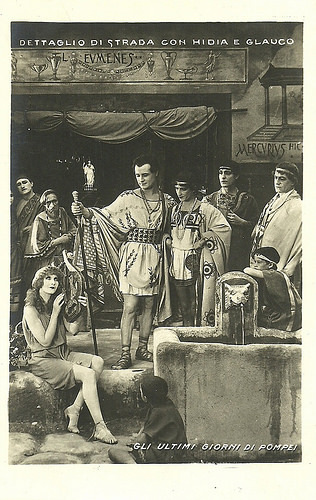
Italian postcard by C. Chierichetti, Milano. Photo: Grandi Films, Roma. Publicity still for Gli ultimi giorni di Pompei/The Last Days of Pompeii (Amleto Palermi, Carmine Gallone, 1926).
Pompeian street life with the rich Greek Glaucus ( Victor Varconi ) and his wealthy friends meeting the blind flower girl Nydia ( Maria Corda ), who also sings and plays the lyre. The bearded man left in the back is Burbo (Carlo Duse), the brutal tavern owner, who owns Nydia as a slave.
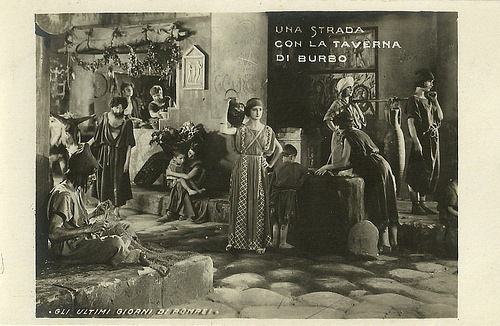
Italian postcard by C. Chierichetti, Milano. Photo: Grandi Films, Roma. Publicity still for Gli ultimi giorni di Pompei/The Last Days of Pompeii (Amleto Palermi, Carmine Gallone, 1926).
A Pompeiian street with Burbo's tavern. Sets were by Vittorio Cafiero, costumes by Duilio Cambellotti.
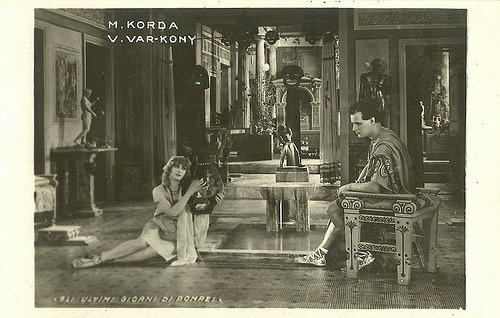
Italian postcard by C. Chierichetti, Milano. Photo: Grandi Films, Roma. Publicity still for Gli ultimi giorni di Pompei/The Last Days of Pompeii (Amleto Palermi, Carmine Gallone, 1926).
Glaucus ( Victor Varconi ) has saved Nydia ( Maria Corda ) from Burbo and taken into his house. Nydia loves Glaucus, but he can only think of Ione.
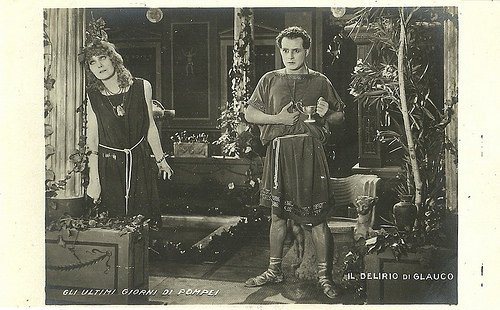
Italian postcard by C. Chierichetti, Milano. Photo: Grandi Films, Roma. Publicity still for Gli ultimi giorni di Pompei/The Last Days of Pompeii (Amleto Palermi, Carmine Gallone, 1926).
Nydia, in love with Glaucus, thinks she has given Glaucus a love potion, but instead it makes him delirious. It is Arbaces who has concocted this.
The Novel and the painting
The novel The Last Days of Pompeii was written by the baron Edward Bulwer-Lytton in 1834. The novel was inspired by the painting The Last Day of Pompeii by the Russian painter Karl Briullov, which Bulwer-Lytton had seen in Milan.
The novel culminates in the cataclysmic destruction of the city of Pompeii by the eruption of Mount Vesuvius in AD 79. The novel became a bestseller, helped on its release by the eruption of Vesuvius just before publication.
The Last Days of Pompeii uses its characters to contrast the decadent culture of 1st-century Rome with both older cultures and coming trends. The protagonist, Glaucus, a handsome Athenian nobleman and Ione's betrothed, represents the Greeks who have been subordinated by Rome.
His nemesis is Arbaces, a scheming Egyptian sorcerer and a high priest of Isis, and the former guardian of Ione and her brother Apaecides. Arbaces represents the still older culture of Egypt. He murders Apaecides and frames Glaucus for the crime. Repeatedly he attempts to seduce Ione.
Olinthus is the chief representative of the nascent Christian religion, which is presented favourably but not uncritically. The Christian converts Apaecides to Christianity and is sentenced to death for his religion.
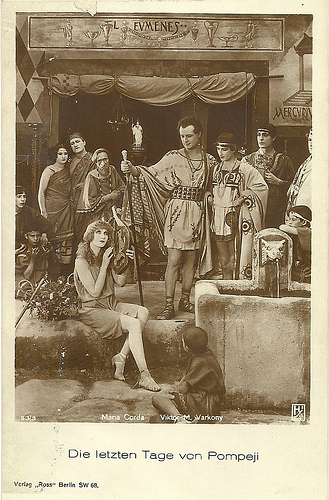
German postcard by Ross Verlag, no. 53/3. Photo: Hisa Film-Vertrieb. Publicity still for Gli ultimi giorni di Pompei/The Last Days of Pompeii (Carmine Gallone, Amleto Palermi, 1926). Collection: Didier Hanson.
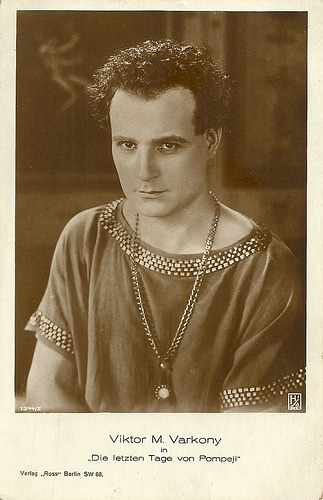
German postcard by Ross Verlag, no. 1344/2, 1927-1928. Photo: Hisa Film-Vertrieb. Publicity still for Gli ultimi giorni di Pompei/The Last Days of Pompeii (Carmine Gallone, Amleto Palermi, 1926). Victor Varconi as Glaucus.
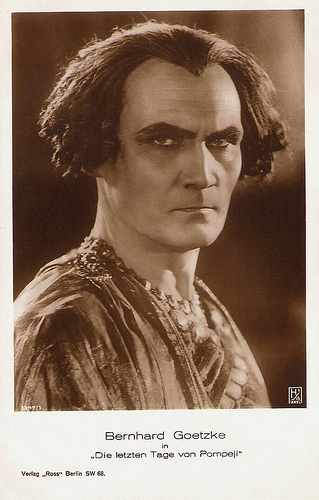
German postcard by Ross Verlag, no. 1347/1, 1927-1928. Photo: Hisa Film-Vertrieb. Publicity still for Gli ultimi giorni di Pompei/The Last Days of Pompeii (Carmine Gallone, Amleto Palermi, 1926). Bernhard Goetzke as the evil Egyptian priest Arbaces.
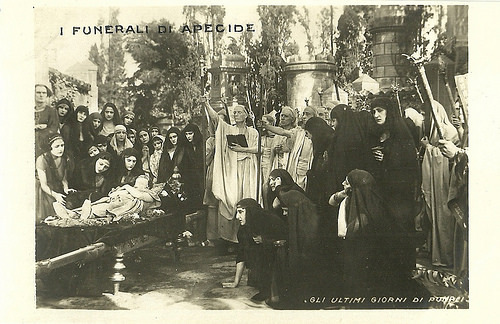
Italian postcard by C. Chierichetti, Milano. Photo: Grandi Films, Roma. Publicity still for Gli ultimi giorni di Pompei/The Last Days of Pompeii (Amleto Palermi, Carmine Gallone, 1926).
The funeral of Apecides (Vittorio Evangelisti). Apecides, brother of Glaucus' lover Ione and former pupil of the Egyptian high priest of Isis, Arbaces, has converted to Christianity and threatens to unmask Arbaces's frauds. Arbaces stabs him and puts the blame on Glaucus, drugged unknowingly by Nydia. The priest in the middle is Calenus ( Emilio Ghione ), who has seen Arbaces murdering Apecides. Arbaces himself ( Bernhard Goetzke ) can be seen extreme left.
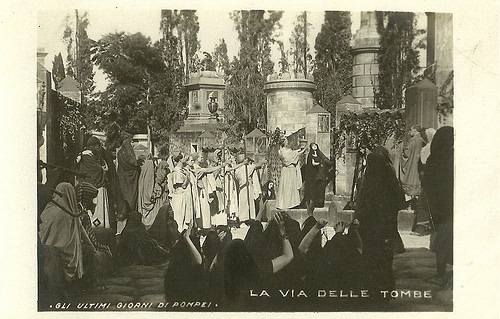
Italian postcard by C. Chierichetti, Milano. Photo: Grandi Films, Roma. Publicity still for Gli ultimi giorni di Pompei/The Last Days of Pompeii (Amleto Palermi, Carmine Gallone, 1926).
At the Via delle Tombe in Pompeii the funeral service for the murdered Apecides is held. In the centre is the priest Calenus ( Emilio Ghione ).
The Star Cast
Handsome Victor Varconi (1891–1976) was as Glaucus the male star of Gli ultimi giorni di Pompei/The Last Days of Pompeii. The Hungarian Varconi, originally Viktor Varkony, was a highly successful matinee idol of the Hungarian-Austrian and German silent cinema in the 1910s and early 1920s. Later he was the first Hungarian actor to become a Hollywood star until the sound film completely altered the course of his career.
Hungarian Maria Corda (1898-1975) played the slave girl Nydia, who is in love with Glaucus. Corda was an immensely popular star of the silent cinema of Austria and Germany. The pretty, blonde actress was a queen of the popular epic spectacles of the 1920s, which were often directed by her husband, Alexander Korda.
Not pictured on one of the postcards is Rina De Liguoro (1892-1966) as Ione. She was the last diva of the Italian silent cinema of the 1920s. De Liguoro had her breakthrough in 1924 as the sensual, untamed Roman empress Messalina, and the beautiful countess continued her glittering career in such epics as Quo Vadis (1924), Casanova (1927) and Cecil B. De Mille's notorious box office flop Madam Satan (1930).
Emilio Ghione (1879-1930), who played Calenus, was an Italian silent film actor, director and screenwriter. He is best known for writing, directing and starring in the Za La Mort series of adventure films, in which he played a likeable French apache and 'honest outlaw.'
The evil Egyptian priest Arbaces was played by German film actor Bernhard Goetzke (1884–1964). He was one of the impressive stars of German silent cinema, in particular in the films by Fritz Lang. Goetzke appeared in 130 films between 1917 and 1961.
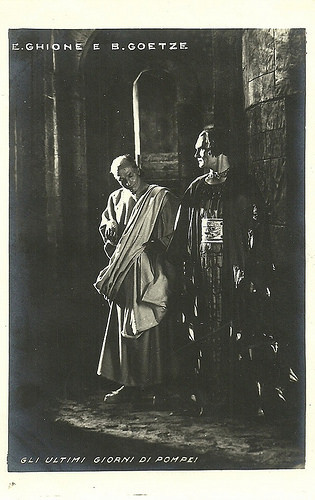
Italian postcard by C. Chierichetti, Milano. Photo: Grandi Films, Roma. Publicity still for Gli ultimi giorni di Pompei/The Last Days of Pompeii (Amleto Palermi, Carmine Gallone, 1926).
Calenus ( Emilio Ghione ) tries to blackmail Arbaces ( Bernhard Goetzke ). Arbaces leads him to his treasury.
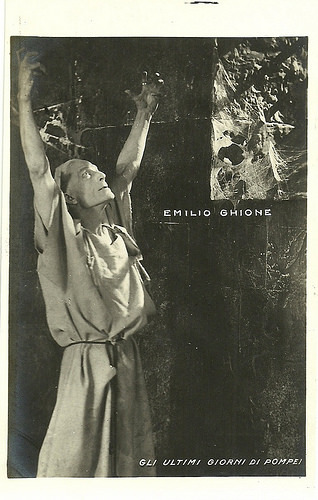
Italian postcard by C. Chierichetti, Milano. Photo: Grandi Films, Roma. Publicity still for Gli ultimi giorni di Pompei/The Last Days of Pompeii (Amleto Palermi, Carmine Gallone, 1926).
Calenus ( Emilio Ghione ) has been fooled by Arbaces and is locked up in the treasury, which is also a dungeon.
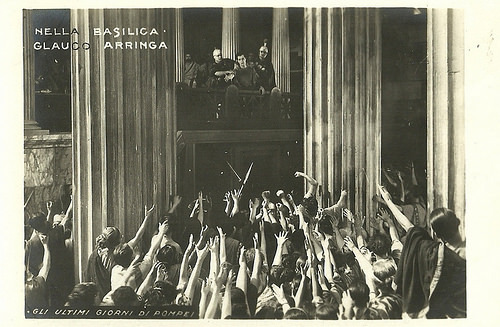
Italian postcard by C. Chierichetti, Milano. Photo: Grandi Films, Roma. Publicity still for Gli ultimi giorni di Pompei/The Last Days of Pompeii (Amleto Palermi, Carmine Gallone, 1926).
At the basilica (courts of justice). Glaucus ( Victor Varconi ) is sentenced to die.
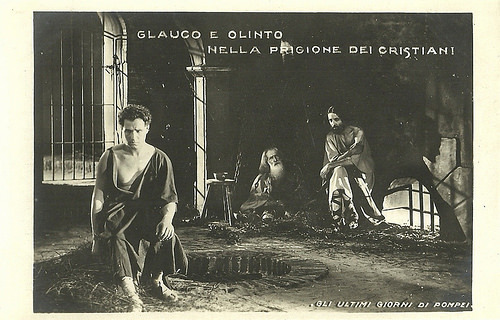
Italian postcard by C. Chierichetti, Milano. Photo: Grandi Films, Roma. Publicity still for Gli ultimi giorni di Pompei/The Last Days of Pompeii (Amleto Palermi, Carmine Gallone, 1926).
Glaucus ( Victor Varconi ) and the Christian Olintus (Ferruccio Biancini), the man on the right, in the prison of the Christians, waiting for their ordeal in the arena.
The adaptations
The first theatrical adaptation of The Last Days of Pompeii was Errico Petrella's opera Jone, with a libretto by Giovanni Peruzzini. It premiered at La Scala in 1858. It was very successful and remained in the Italian repertoire well into the 20th century. In 1877 followed an ambitious theatrical adaptation, which was mounted at the Queen's Theatre, Long Acre in London. It featured a staged eruption of the Vesuvius, an earthquake and a sybaritic Roman feast – the earth did not quake, the volcano did not work, acrobats fell onto the cast below, and the production was an expensive flop.
The first film version was the British short film The Last Days of Pompeii (1900), directed by Walter R. Booth. Eight years later followed Gli ultimi giorni di Pompei/The Last Days of Pompeii (Arturo Ambrosio, Luigi Maggi, 1908). In 1913 followed to more Italian silent film versions, Gli ultimi giorni di Pompei/The Last Days of Pompeii (Mario Caserini, 1913), and Jone ovvero gli ultimi giorni di Pompei/Jone or the Last Days of Pompeii (Giovanni Enrico Vidali, Ubaldo Maria Del Colle, 1913).
The first sound version was the Hollywood production The Last Days of Pompeii (Ernest B. Schoedsack, Merian C. Cooper, 1935), with Preston Foster and Basil Rathbone. It carried a disclaimer that, although the movie used the novel's description of Pompei, it did not use its plot or characters. The film was a moderate success on its initial release, but made an overall loss of $237,000.
After the war followed the French-Italian version Gli ultimi giorni di Pompei/Les Derniers Jours de Pompéi/The Last Days of Pompeii (Marcel L'Herbier, Paolo Moffa, 1950), starring Micheline Presle and Georges Marchal . The amphitheatre scenes were filmed at the Arena di Verona. The next adaptation was another Italian version, Gli ultimi giorni di Pompei/The Last Days of Pompeii (Sergio Leone, 1959), starring Steve Reeves. Mario Bonnard, the original director, fell ill on the first day of shooting, so assistant director Leone and the scriptwriters finished the film. Later followed two TV versions and a German stage musical, Pompeji (2008).
But how was the 1926 version? David Melville reviews at IMDb : "The last of the great silent Italian epics, The Last Days of Pompeii is as lavish as anything produced by Hollywood at that time - only much, much raunchier. During an orgy in the house of the evil priest Arbaces, naked slave girls are served up (literally!) on platters decked with flowers. A nubile mummy rises out of her sarcophagus to do a striptease and bare-breasted sphinx statues come to life as her chorus line. In the gladiators' tavern, wildly effeminate men (kohl-dark eyelids and lipstick as thick as clotted blood) drool and bat their eyes over so much naked, muscular flesh. All in all, the most satisfyingly decadent Ancient Rome saga until Fellini Satyricon in 1968!"
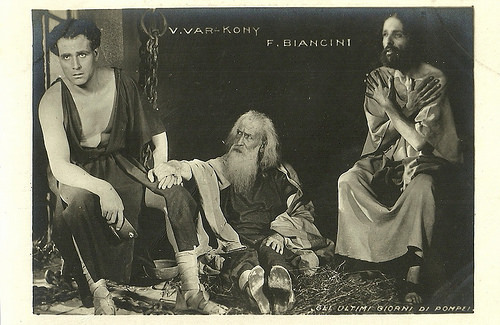
Italian postcard by C. Chierichetti, Milano. Photo: Grandi Films, Roma. Publicity still for Gli ultimi giorni di Pompei/The Last Days of Pompeii (Amleto Palermi, Carmine Gallone, 1926).
Glaucus ( Victor Varconi ) in prison. The man on the right is the Christian Olintus (Ferruccio Biancini), who had converted Apecides. Olintus will see the eruption and destruction of Pompeii as a punishment of God.
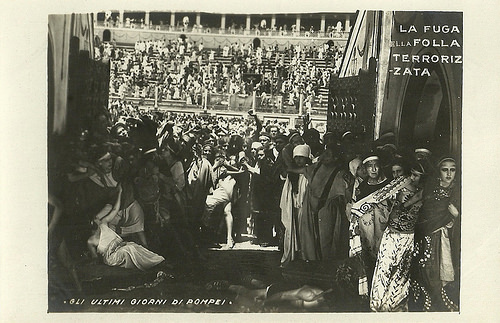
Italian postcard by C. Chierichetti, Milano. Photo: Grandi Films, Roma. Publicity still for Gli ultimi giorni di Pompei/The Last Days of Pompeii (Amleto Palermi, Carmine Gallone, 1926).
Glaucus is sentenced to die in the arena, eaten by lions, when just in time Glaucus's friend Sallustius, Nydia, Ione and Calenus expose Arbaces as the real murderer and he threatens to be lynched by the mob. Suddenly the Vesuvius erupts and the terrorised people flee.
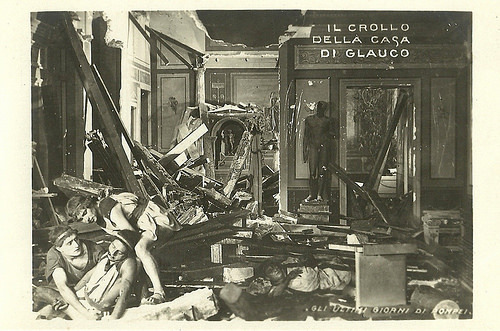
Italian postcard by C. Chierichetti, Milano. Photo: Grandi Films, Roma. Publicity still for Gli ultimi giorni di Pompei/The Last Days of Pompeii (Amleto Palermi, Carmine Gallone, 1926).
The destruction of the house of Glaucus.
Sources: David Melville (IMDb), Wikipedia and IMDb.

Italian postcard by C. Chierichetti, Milano. Photo: Grandi Films, Roma. Publicity still for Gli ultimi giorni di Pompei/The Last Days of Pompeii (Amleto Palermi, Carmine Gallone, 1926).
Glaucus ( Victor Varconi ) training at the gymnasium.

Italian postcard by C. Chierichetti, Milano. Photo: Grandi Films, Roma. Publicity still for Gli ultimi giorni di Pompei/The Last Days of Pompeii (Amleto Palermi, Carmine Gallone, 1926).
Pompeian street life with the rich Greek Glaucus ( Victor Varconi ) and his wealthy friends meeting the blind flower girl Nydia ( Maria Corda ), who also sings and plays the lyre. The bearded man left in the back is Burbo (Carlo Duse), the brutal tavern owner, who owns Nydia as a slave.

Italian postcard by C. Chierichetti, Milano. Photo: Grandi Films, Roma. Publicity still for Gli ultimi giorni di Pompei/The Last Days of Pompeii (Amleto Palermi, Carmine Gallone, 1926).
A Pompeiian street with Burbo's tavern. Sets were by Vittorio Cafiero, costumes by Duilio Cambellotti.

Italian postcard by C. Chierichetti, Milano. Photo: Grandi Films, Roma. Publicity still for Gli ultimi giorni di Pompei/The Last Days of Pompeii (Amleto Palermi, Carmine Gallone, 1926).
Glaucus ( Victor Varconi ) has saved Nydia ( Maria Corda ) from Burbo and taken into his house. Nydia loves Glaucus, but he can only think of Ione.

Italian postcard by C. Chierichetti, Milano. Photo: Grandi Films, Roma. Publicity still for Gli ultimi giorni di Pompei/The Last Days of Pompeii (Amleto Palermi, Carmine Gallone, 1926).
Nydia, in love with Glaucus, thinks she has given Glaucus a love potion, but instead it makes him delirious. It is Arbaces who has concocted this.
The Novel and the painting
The novel The Last Days of Pompeii was written by the baron Edward Bulwer-Lytton in 1834. The novel was inspired by the painting The Last Day of Pompeii by the Russian painter Karl Briullov, which Bulwer-Lytton had seen in Milan.
The novel culminates in the cataclysmic destruction of the city of Pompeii by the eruption of Mount Vesuvius in AD 79. The novel became a bestseller, helped on its release by the eruption of Vesuvius just before publication.
The Last Days of Pompeii uses its characters to contrast the decadent culture of 1st-century Rome with both older cultures and coming trends. The protagonist, Glaucus, a handsome Athenian nobleman and Ione's betrothed, represents the Greeks who have been subordinated by Rome.
His nemesis is Arbaces, a scheming Egyptian sorcerer and a high priest of Isis, and the former guardian of Ione and her brother Apaecides. Arbaces represents the still older culture of Egypt. He murders Apaecides and frames Glaucus for the crime. Repeatedly he attempts to seduce Ione.
Olinthus is the chief representative of the nascent Christian religion, which is presented favourably but not uncritically. The Christian converts Apaecides to Christianity and is sentenced to death for his religion.

German postcard by Ross Verlag, no. 53/3. Photo: Hisa Film-Vertrieb. Publicity still for Gli ultimi giorni di Pompei/The Last Days of Pompeii (Carmine Gallone, Amleto Palermi, 1926). Collection: Didier Hanson.

German postcard by Ross Verlag, no. 1344/2, 1927-1928. Photo: Hisa Film-Vertrieb. Publicity still for Gli ultimi giorni di Pompei/The Last Days of Pompeii (Carmine Gallone, Amleto Palermi, 1926). Victor Varconi as Glaucus.

German postcard by Ross Verlag, no. 1347/1, 1927-1928. Photo: Hisa Film-Vertrieb. Publicity still for Gli ultimi giorni di Pompei/The Last Days of Pompeii (Carmine Gallone, Amleto Palermi, 1926). Bernhard Goetzke as the evil Egyptian priest Arbaces.

Italian postcard by C. Chierichetti, Milano. Photo: Grandi Films, Roma. Publicity still for Gli ultimi giorni di Pompei/The Last Days of Pompeii (Amleto Palermi, Carmine Gallone, 1926).
The funeral of Apecides (Vittorio Evangelisti). Apecides, brother of Glaucus' lover Ione and former pupil of the Egyptian high priest of Isis, Arbaces, has converted to Christianity and threatens to unmask Arbaces's frauds. Arbaces stabs him and puts the blame on Glaucus, drugged unknowingly by Nydia. The priest in the middle is Calenus ( Emilio Ghione ), who has seen Arbaces murdering Apecides. Arbaces himself ( Bernhard Goetzke ) can be seen extreme left.

Italian postcard by C. Chierichetti, Milano. Photo: Grandi Films, Roma. Publicity still for Gli ultimi giorni di Pompei/The Last Days of Pompeii (Amleto Palermi, Carmine Gallone, 1926).
At the Via delle Tombe in Pompeii the funeral service for the murdered Apecides is held. In the centre is the priest Calenus ( Emilio Ghione ).
The Star Cast
Handsome Victor Varconi (1891–1976) was as Glaucus the male star of Gli ultimi giorni di Pompei/The Last Days of Pompeii. The Hungarian Varconi, originally Viktor Varkony, was a highly successful matinee idol of the Hungarian-Austrian and German silent cinema in the 1910s and early 1920s. Later he was the first Hungarian actor to become a Hollywood star until the sound film completely altered the course of his career.
Hungarian Maria Corda (1898-1975) played the slave girl Nydia, who is in love with Glaucus. Corda was an immensely popular star of the silent cinema of Austria and Germany. The pretty, blonde actress was a queen of the popular epic spectacles of the 1920s, which were often directed by her husband, Alexander Korda.
Not pictured on one of the postcards is Rina De Liguoro (1892-1966) as Ione. She was the last diva of the Italian silent cinema of the 1920s. De Liguoro had her breakthrough in 1924 as the sensual, untamed Roman empress Messalina, and the beautiful countess continued her glittering career in such epics as Quo Vadis (1924), Casanova (1927) and Cecil B. De Mille's notorious box office flop Madam Satan (1930).
Emilio Ghione (1879-1930), who played Calenus, was an Italian silent film actor, director and screenwriter. He is best known for writing, directing and starring in the Za La Mort series of adventure films, in which he played a likeable French apache and 'honest outlaw.'
The evil Egyptian priest Arbaces was played by German film actor Bernhard Goetzke (1884–1964). He was one of the impressive stars of German silent cinema, in particular in the films by Fritz Lang. Goetzke appeared in 130 films between 1917 and 1961.

Italian postcard by C. Chierichetti, Milano. Photo: Grandi Films, Roma. Publicity still for Gli ultimi giorni di Pompei/The Last Days of Pompeii (Amleto Palermi, Carmine Gallone, 1926).
Calenus ( Emilio Ghione ) tries to blackmail Arbaces ( Bernhard Goetzke ). Arbaces leads him to his treasury.

Italian postcard by C. Chierichetti, Milano. Photo: Grandi Films, Roma. Publicity still for Gli ultimi giorni di Pompei/The Last Days of Pompeii (Amleto Palermi, Carmine Gallone, 1926).
Calenus ( Emilio Ghione ) has been fooled by Arbaces and is locked up in the treasury, which is also a dungeon.

Italian postcard by C. Chierichetti, Milano. Photo: Grandi Films, Roma. Publicity still for Gli ultimi giorni di Pompei/The Last Days of Pompeii (Amleto Palermi, Carmine Gallone, 1926).
At the basilica (courts of justice). Glaucus ( Victor Varconi ) is sentenced to die.

Italian postcard by C. Chierichetti, Milano. Photo: Grandi Films, Roma. Publicity still for Gli ultimi giorni di Pompei/The Last Days of Pompeii (Amleto Palermi, Carmine Gallone, 1926).
Glaucus ( Victor Varconi ) and the Christian Olintus (Ferruccio Biancini), the man on the right, in the prison of the Christians, waiting for their ordeal in the arena.
The adaptations
The first theatrical adaptation of The Last Days of Pompeii was Errico Petrella's opera Jone, with a libretto by Giovanni Peruzzini. It premiered at La Scala in 1858. It was very successful and remained in the Italian repertoire well into the 20th century. In 1877 followed an ambitious theatrical adaptation, which was mounted at the Queen's Theatre, Long Acre in London. It featured a staged eruption of the Vesuvius, an earthquake and a sybaritic Roman feast – the earth did not quake, the volcano did not work, acrobats fell onto the cast below, and the production was an expensive flop.
The first film version was the British short film The Last Days of Pompeii (1900), directed by Walter R. Booth. Eight years later followed Gli ultimi giorni di Pompei/The Last Days of Pompeii (Arturo Ambrosio, Luigi Maggi, 1908). In 1913 followed to more Italian silent film versions, Gli ultimi giorni di Pompei/The Last Days of Pompeii (Mario Caserini, 1913), and Jone ovvero gli ultimi giorni di Pompei/Jone or the Last Days of Pompeii (Giovanni Enrico Vidali, Ubaldo Maria Del Colle, 1913).
The first sound version was the Hollywood production The Last Days of Pompeii (Ernest B. Schoedsack, Merian C. Cooper, 1935), with Preston Foster and Basil Rathbone. It carried a disclaimer that, although the movie used the novel's description of Pompei, it did not use its plot or characters. The film was a moderate success on its initial release, but made an overall loss of $237,000.
After the war followed the French-Italian version Gli ultimi giorni di Pompei/Les Derniers Jours de Pompéi/The Last Days of Pompeii (Marcel L'Herbier, Paolo Moffa, 1950), starring Micheline Presle and Georges Marchal . The amphitheatre scenes were filmed at the Arena di Verona. The next adaptation was another Italian version, Gli ultimi giorni di Pompei/The Last Days of Pompeii (Sergio Leone, 1959), starring Steve Reeves. Mario Bonnard, the original director, fell ill on the first day of shooting, so assistant director Leone and the scriptwriters finished the film. Later followed two TV versions and a German stage musical, Pompeji (2008).
But how was the 1926 version? David Melville reviews at IMDb : "The last of the great silent Italian epics, The Last Days of Pompeii is as lavish as anything produced by Hollywood at that time - only much, much raunchier. During an orgy in the house of the evil priest Arbaces, naked slave girls are served up (literally!) on platters decked with flowers. A nubile mummy rises out of her sarcophagus to do a striptease and bare-breasted sphinx statues come to life as her chorus line. In the gladiators' tavern, wildly effeminate men (kohl-dark eyelids and lipstick as thick as clotted blood) drool and bat their eyes over so much naked, muscular flesh. All in all, the most satisfyingly decadent Ancient Rome saga until Fellini Satyricon in 1968!"

Italian postcard by C. Chierichetti, Milano. Photo: Grandi Films, Roma. Publicity still for Gli ultimi giorni di Pompei/The Last Days of Pompeii (Amleto Palermi, Carmine Gallone, 1926).
Glaucus ( Victor Varconi ) in prison. The man on the right is the Christian Olintus (Ferruccio Biancini), who had converted Apecides. Olintus will see the eruption and destruction of Pompeii as a punishment of God.

Italian postcard by C. Chierichetti, Milano. Photo: Grandi Films, Roma. Publicity still for Gli ultimi giorni di Pompei/The Last Days of Pompeii (Amleto Palermi, Carmine Gallone, 1926).
Glaucus is sentenced to die in the arena, eaten by lions, when just in time Glaucus's friend Sallustius, Nydia, Ione and Calenus expose Arbaces as the real murderer and he threatens to be lynched by the mob. Suddenly the Vesuvius erupts and the terrorised people flee.

Italian postcard by C. Chierichetti, Milano. Photo: Grandi Films, Roma. Publicity still for Gli ultimi giorni di Pompei/The Last Days of Pompeii (Amleto Palermi, Carmine Gallone, 1926).
The destruction of the house of Glaucus.
Sources: David Melville (IMDb), Wikipedia and IMDb.
Published on October 27, 2015 23:00
October 26, 2015
Maria Brockerhoff
German actress and model Maria Brockerhoff (1942) was a popular starlet and magazine pin-up in the late 1960s. Her films may be forgotten but her postcards with photos by Bernard of Hollywood are still delicious.
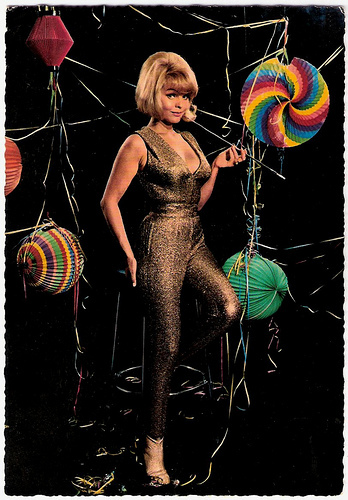
German postcard by Krüger, no. 902/368. Photo: Bernard of Hollywood.
Attractive Eyecatcher
Maria Brockerhoff was born in Hamburg, Germany, in 1942. When she studied graphic design, she also worked as a mannequin. During a contest she was chosen as ‘Deutschen Gretchen 65’.
This led to parts in a series of film comedies. The first was Die schwedische Jungfrau/The Virgin from Sweden (Kurt Wilhelm, 1964), starring Paul Hubschmid and Letitia Roman.
Other titles are the Schlagerfilms Ich kauf' mir lieber einen Tirolerhut/I Rather Buy Myself a Tirolean Hat (Hans Bilian, 1965) with Manfred Schnelldorfer and Hannelore Auer , and Komm mit zur blauen Adria/Come Along To The Blue Adriatic (Lothar Gündisch, 1966) with Dietmar Schönherr .
In all these light entertainment films, the beautiful blonde Brockerhoff was merely an attractive eyecatcher.
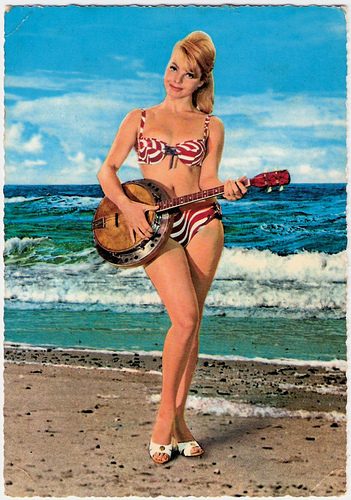
German postcard by Krüger, no. 903/366. Photo: Bernard of Hollywood.

German postcard by Krüger, no. 902/364. Photo: Bernard of Hollywood.
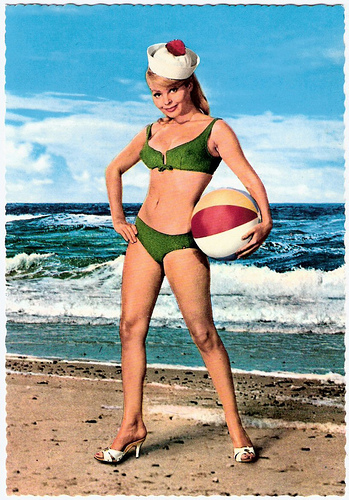
German postcard by Krüger, no. 902/367. Photo: Bernard of Hollywood.
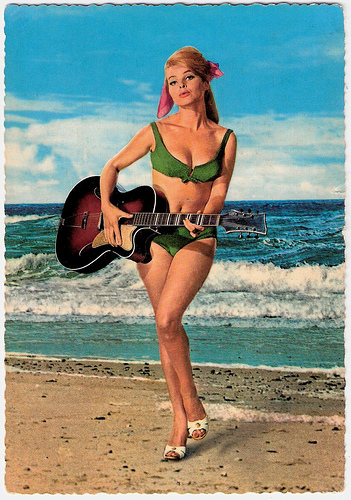
German postcard by Krüger, no. 902/365. Photo: Bernard of Hollywood.
Playboy Covergirl
In 1965 Maria Brockerhoff traveled to Hollywood to play a part in the action film The Silencers (Phil Karlson, 1966), starring Dean Martin as secret agent Matt Helm. This opportunity fell through because she had not obtained a working permit.
In 1966 she could be seen in 26 illustrated magazines, and she appeared in an uncredited bit role at the side of French star Jean Marais in Le saint prend l’affut/The Saint Lies in Wait (Christian-Jacque, 1966) based on the detective novels by Leslie Charteris.
In 1967 she went again to Hollywood, but negotiations with Columbia Pictures failed when the film studio demanded a seven-year contract.
In Germany she played in erotic films like Pension Clausewitz/Clausewitz Inn (Ralph Habib, 1967) and Komm nur, mein liebstes Vögelein/Come Now, My Dear Little Bird (Rolf Thiele, 1968).
And she was the covergirl of the US edition of Playboy in December 1968. IMDb lists also several cover photos of magazines like Parade (UK), Wochenend (West Germany) and Quick (West Germany).
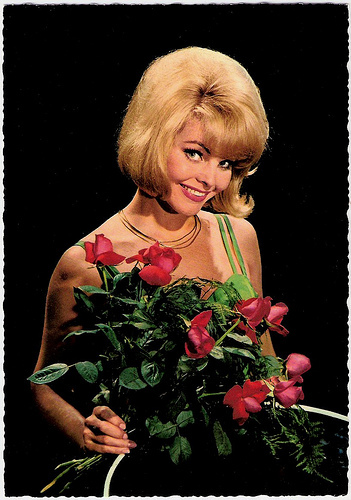
German postcard by Krüger, no. 902/369. Photo: Bernard of Hollywood.
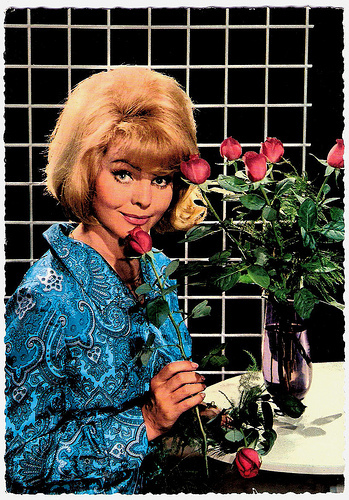
German postcard by Krüger, no. 902/362. Photo: Bernard of Hollywood.
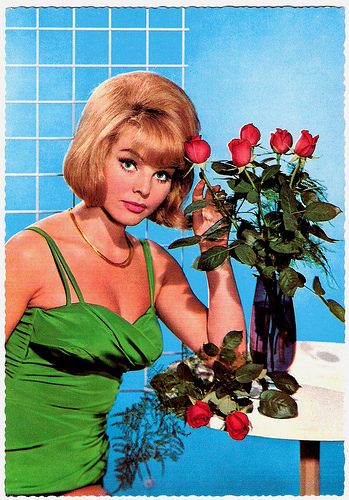
German postcard by Krüger, no. 900/290. Photo: Bernard of Hollywood.
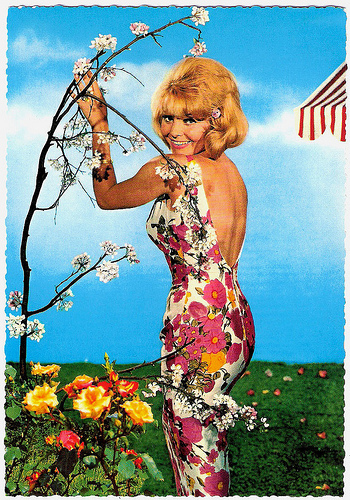
German postcard by Krüger, no. 902/363. Photo: Bernard of Hollywood.
Sex Comedies
Maria Brockerhoff then appeared in six films in two years, and she finally appeared in an English language film. She had a supporting part in the American-British war film Hannibal Brooks (Michael Winner, 1969) starring Oliver Reed. Albert Ohayon at IMDb : "What can you say about a war movie where an elephant crosses the Alps? It's silly but a heck of a lot of fun. The scenery is gorgeous, the acting is light and the action sequences are top notch. Oliver Reed is perfectly cast as our hero Brooks. He has played so many villain roles that it's great to see him play a nice guy for a change."
Her other less interesting films were made in Germany: the comedy Unser Doktor ist der Beste/Our Doctor Is The Best (Harald Vock, 1969) starring Schlager singer Roy Black , Hugo der Weiberschreck/Hugo, the Woman Chaser (Hans Albin, 1969) with Peter Garden , the sex comedy Die Jungfrauen von Bumshausen/Run, Virgin, Run (Hans Billian, 1970), another sex comedy Frisch, fromm, fröhlich, frei/Renewed, Pious, Happy and Free (Rolf Thiele, 1970) with Horst Frank, and Hurra, ein toller Onkel wird Papa/Hooray, a Super Uncle is a Father (Hans Albin, 1970).
Maria also appeared regularly on German television. She was a permanent cast member of the series Luftsprünge/Bounces (1969). She also made guest appearances in episode of popular Krimi series like Tatort (1972), Der Kommissar (1973) and Bitte keine Polizei/Please No Police (1975). In the mid-1970s the media lost their interest in her. She worked for a while for an advertising agency in München (Munich).
In 1979, Maria Brockerhoff married to George E. Lombard, an American manager of the Lockheed firm. The couple moved to California. There she lives under the name of Maria Lombard.
Theatrical trailer Hannibal Brooks (1969). Source: TaylorHamKid (YouTube).
English language trailer of Die Jungfrauen von Bumshausen/Run Virgin Run (1970). Source: Vicious Habits (YouTube).
Sources: Wikipedia (German), and .

German postcard by Krüger, no. 902/368. Photo: Bernard of Hollywood.
Attractive Eyecatcher
Maria Brockerhoff was born in Hamburg, Germany, in 1942. When she studied graphic design, she also worked as a mannequin. During a contest she was chosen as ‘Deutschen Gretchen 65’.
This led to parts in a series of film comedies. The first was Die schwedische Jungfrau/The Virgin from Sweden (Kurt Wilhelm, 1964), starring Paul Hubschmid and Letitia Roman.
Other titles are the Schlagerfilms Ich kauf' mir lieber einen Tirolerhut/I Rather Buy Myself a Tirolean Hat (Hans Bilian, 1965) with Manfred Schnelldorfer and Hannelore Auer , and Komm mit zur blauen Adria/Come Along To The Blue Adriatic (Lothar Gündisch, 1966) with Dietmar Schönherr .
In all these light entertainment films, the beautiful blonde Brockerhoff was merely an attractive eyecatcher.

German postcard by Krüger, no. 903/366. Photo: Bernard of Hollywood.

German postcard by Krüger, no. 902/364. Photo: Bernard of Hollywood.

German postcard by Krüger, no. 902/367. Photo: Bernard of Hollywood.

German postcard by Krüger, no. 902/365. Photo: Bernard of Hollywood.
Playboy Covergirl
In 1965 Maria Brockerhoff traveled to Hollywood to play a part in the action film The Silencers (Phil Karlson, 1966), starring Dean Martin as secret agent Matt Helm. This opportunity fell through because she had not obtained a working permit.
In 1966 she could be seen in 26 illustrated magazines, and she appeared in an uncredited bit role at the side of French star Jean Marais in Le saint prend l’affut/The Saint Lies in Wait (Christian-Jacque, 1966) based on the detective novels by Leslie Charteris.
In 1967 she went again to Hollywood, but negotiations with Columbia Pictures failed when the film studio demanded a seven-year contract.
In Germany she played in erotic films like Pension Clausewitz/Clausewitz Inn (Ralph Habib, 1967) and Komm nur, mein liebstes Vögelein/Come Now, My Dear Little Bird (Rolf Thiele, 1968).
And she was the covergirl of the US edition of Playboy in December 1968. IMDb lists also several cover photos of magazines like Parade (UK), Wochenend (West Germany) and Quick (West Germany).

German postcard by Krüger, no. 902/369. Photo: Bernard of Hollywood.

German postcard by Krüger, no. 902/362. Photo: Bernard of Hollywood.

German postcard by Krüger, no. 900/290. Photo: Bernard of Hollywood.

German postcard by Krüger, no. 902/363. Photo: Bernard of Hollywood.
Sex Comedies
Maria Brockerhoff then appeared in six films in two years, and she finally appeared in an English language film. She had a supporting part in the American-British war film Hannibal Brooks (Michael Winner, 1969) starring Oliver Reed. Albert Ohayon at IMDb : "What can you say about a war movie where an elephant crosses the Alps? It's silly but a heck of a lot of fun. The scenery is gorgeous, the acting is light and the action sequences are top notch. Oliver Reed is perfectly cast as our hero Brooks. He has played so many villain roles that it's great to see him play a nice guy for a change."
Her other less interesting films were made in Germany: the comedy Unser Doktor ist der Beste/Our Doctor Is The Best (Harald Vock, 1969) starring Schlager singer Roy Black , Hugo der Weiberschreck/Hugo, the Woman Chaser (Hans Albin, 1969) with Peter Garden , the sex comedy Die Jungfrauen von Bumshausen/Run, Virgin, Run (Hans Billian, 1970), another sex comedy Frisch, fromm, fröhlich, frei/Renewed, Pious, Happy and Free (Rolf Thiele, 1970) with Horst Frank, and Hurra, ein toller Onkel wird Papa/Hooray, a Super Uncle is a Father (Hans Albin, 1970).
Maria also appeared regularly on German television. She was a permanent cast member of the series Luftsprünge/Bounces (1969). She also made guest appearances in episode of popular Krimi series like Tatort (1972), Der Kommissar (1973) and Bitte keine Polizei/Please No Police (1975). In the mid-1970s the media lost their interest in her. She worked for a while for an advertising agency in München (Munich).
In 1979, Maria Brockerhoff married to George E. Lombard, an American manager of the Lockheed firm. The couple moved to California. There she lives under the name of Maria Lombard.
Theatrical trailer Hannibal Brooks (1969). Source: TaylorHamKid (YouTube).
English language trailer of Die Jungfrauen von Bumshausen/Run Virgin Run (1970). Source: Vicious Habits (YouTube).
Sources: Wikipedia (German), and .
Published on October 26, 2015 23:00
October 25, 2015
Maureen O’Hara (1920-2015)
Last Saturday, Irish born Maureen O’Hara, one of the icons of Hollywood’s Golden Age, has died. The feisty and fearless actress starred in John Ford’s Oscar-winning drama How Green Was My Valley (1941), set in Wales, and Ford’s Irish-set The Quiet Man (1952) opposite John Wayne. The famously red-headed actress also worked successfully with Charles Laughton at Jamaica Inn (1939) and The Hunchback of Notre Dame (1939), starred in the perennial Christmas hit Miracle on 34th Street (1947), and appeared in the Disney children’s hit The Parent Trap (1961). O'Hara was 95.
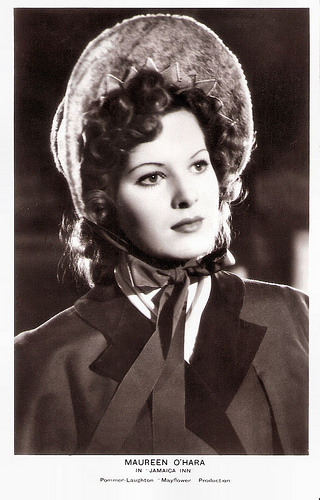
British postcard, London, no. FS 200. Photo: Pommer-Laughton 'Mayflower' production. Publicity still for Jamaica Inn (Alfred Hitchcock, 1939).
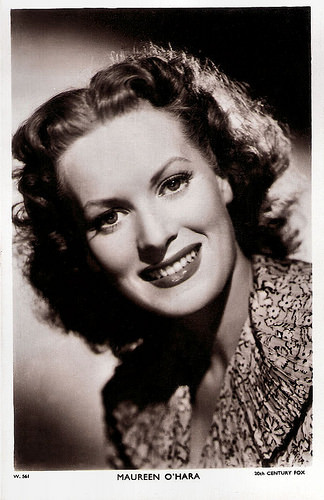
British postcard in the Picturegoer Series, London, no. W 561. Photo: 20th Century Fox.
Alfred Hitchcock
Maureen O’Hara was born Maureen FitzSimons in the Dublin suburb of Ranelagh, Ireland, in 1920. Her mother, Marguerita Lilburn FitzSimons, was an accomplished contralto. Her father, Charles FitzSimons, managed a business in Dublin and also owned part of the renowned Irish soccer team The Shamrock Rovers.
From the age of 6 to 17, Maureen trained in drama, music and dance, and at the age of 10 she joined the Rathmines Theatre Company and worked in amateur theatre in the evenings after her lessons. O'Hara's dream at this time was to be a stage actress. By age 14 she was accepted to the prestigious Abbey Theatre and pursued her dream of classical theatre and operatic singing.
Her first screen test was for a British film called Kicking the Moon Around (Walter Forde, 1938) at Elstree Studios, It was arranged by American bandleader Harry Richman, who was then appearing in Dublin. The result was deemed unsatisfactory, but when Charles Laughton later saw it he was intrigued by her large and expressive eyes.
Laughton arranged for her to co-star with him in the British film Jamaica Inn (Alfred Hitchcock, 1939). Laughton was so pleased with O'Hara's performance that she was cast in the role of Esmeralda opposite him in the Hollywood production of The Hunchback of Notre Dame (William Dieterle, 1939). The epic film was an extraordinary success and international audiences were now alerted to her natural beauty and talent.
From there, she went on to enjoy a long and highly successful career in Hollywood. Director John Ford cast her as Angharad in How Green Was My Valley (1941), which won the Academy Award for Best Picture.
O’Hara was often an example of noble and defiant womanhood, like in This Land Is Mine (Jean Renoir, 1943). In this film, she was reunited with Laughton, who plays a mother-dominated schoolteacher secretly in love with O’Hara, a colleague who is working for the wartime resistance.
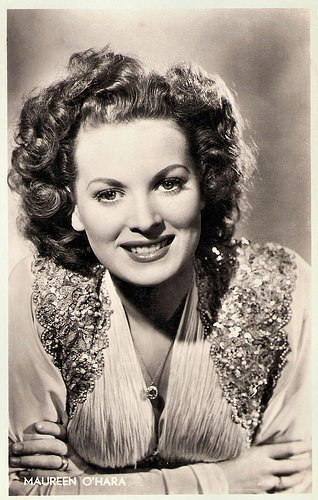
Dutch postcard by J.S.A. Photo: M.P.E.
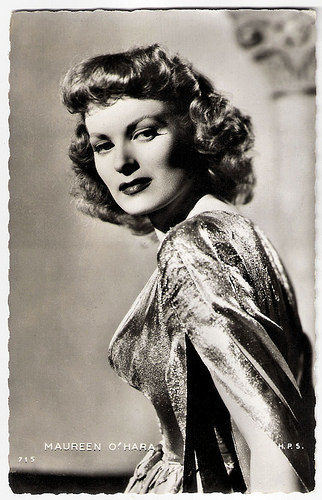
French postcard by Editions P.I., Paris, no. 715. Photo: H.P.S.
John Wayne
Maureen O'Hara starred in Swashbucklers such as The Black Swan (Henry King, 1942), opposite Tyrone Power , and Sinbad the Sailor (Richard Wallace, 1947), with Douglas Fairbanks, Jr. She also starred as Doris Walker and the mother of a young Natalie Wood in Miracle on 34th Street (George Seaton, 1947), which became a perennial Christmas classic.
O'Hara made a number of films with John Wayne. She met Wayne through director John Ford, and the two hit it right off. O'Hara: "I adored him, and he loved me. But we were never sweethearts. Never, ever.”
Opposite Wayne, she played Mary Kate Danaher in The Quiet Man (John Ford, 1952), an iconic film that is still very much celebrated in Ireland and abroad.
In total, they made five films together between 1948 and 1972, also including Rio Grande (John Ford, 1950), The Wings of Eagles (John Ford, 1957), McLintock! (Andrew V. McLaglen, 1963) and Big Jake (George Sherman, 1971).
O’Hara most often played strong and wilful women, but offscreen she was the same. In 1957 her career was threatened by scandal, when the tabloid Confidential magazine claimed she and a man had engaged in 'the hottest show in town' in the back row of Hollywood’s Grauman’s Chinese Theatre. However, as she later told the Associated Press, at the time she “was making a movie in Spain, and I had the passport to prove it”.
She testified against the magazine in a criminal libel trial and brought a lawsuit that was settled out of court. The magazine eventually went out of business.
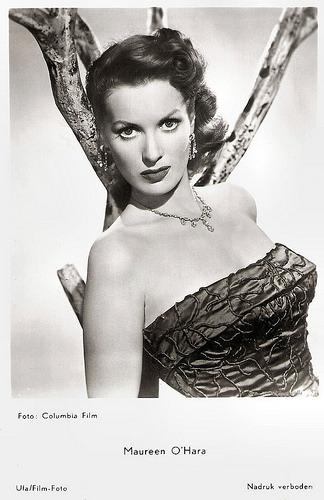
Dutch postcard by Gebr. Spanjersberg N.V., Rotterdam, no. 2028. Photo: Columbia Film / Ufa.
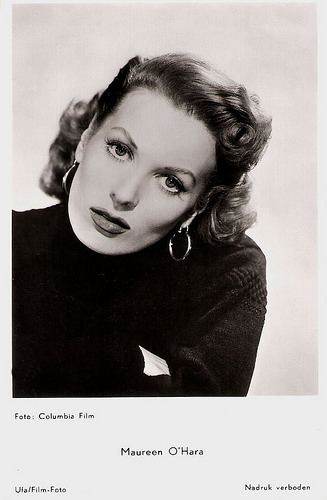
Dutch postcard by Gebr. Spanjersberg N.V., Rotterdam, no. 2029. Photo: Columbia Film / Ufa.
John Candy's domineering mother
Maureen O'Hara was married three times. In 1939, at the age of 19, O'Hara secretly married Englishman George H. Brown, a film producer, production assistant and occasional scriptwriter, who she had met on the set of Jamaica Inn. The marriage was annulled in 1941.
Later that year, O'Hara married American film director William Houston Price (dialogue director in The Hunchback of Notre Dame), but the union ended in 1953, reportedly as a result of his alcohol abuse. They had one child, a daughter named Bronwyn FitzSimons Price (1944).
In later life, Maureen O’Hara married her third husband, Brigadier General Charles Blair. The couple lived in the US Virgin Islands, where he operated an airline. He died in a plane crash in 1978 and O’Hara took over management of the airline, which she eventually sold. “Being married to Charlie Blair and travelling all over the world with him, believe me, was enough for any woman,” she said in 1995. “It was the best time of my life.”
O'Hara remained retired from acting until 1991, when she starred in the film Only the Lonely (Chris Columbus, 1991), playing Rose Muldoon, the domineering mother of a Chicago cop played by John Candy. Ronald Bergan in his obituary in The Guardian: "she acted everyone else off the screen, a reminder of just how much the cinema had missed her."
In the following years, she continued to work, starring in several made-for-TV films. Her autobiography, 'Tis Herself, was published in 2004 and was a New York Times Bestseller. In 2005 she moved back to Ireland, settling in her house on a 35-acre estate, Lugdine Park, in west Cork, which she had bought with Blair in 1970. In 2012 she returned to the US to be closer to her family as her health declined.
She was never nominated for an Oscar, instead being given an honorary award in 2014. After accepting her statuette from a wheelchair, the then 94-year-old star protested when her speech of thanks was cut short.
Maureen O'Hara died in her sleep at home in Boise, Idaho. She is survived by her daughter, Bronwyn, and by a grandson and two great-grandchildren.
Trailer for Jamaica Inn (Alfred Hitchcock, 1939). Source: Cohen Film Collection (YouTube).
Trailer for The Quiet Man (John Ford, 1952). Source: Eurekaentertainment (YouTube).
Sources: Ronald Bergan (The Guardian), Wikipedia and .

British postcard, London, no. FS 200. Photo: Pommer-Laughton 'Mayflower' production. Publicity still for Jamaica Inn (Alfred Hitchcock, 1939).

British postcard in the Picturegoer Series, London, no. W 561. Photo: 20th Century Fox.
Alfred Hitchcock
Maureen O’Hara was born Maureen FitzSimons in the Dublin suburb of Ranelagh, Ireland, in 1920. Her mother, Marguerita Lilburn FitzSimons, was an accomplished contralto. Her father, Charles FitzSimons, managed a business in Dublin and also owned part of the renowned Irish soccer team The Shamrock Rovers.
From the age of 6 to 17, Maureen trained in drama, music and dance, and at the age of 10 she joined the Rathmines Theatre Company and worked in amateur theatre in the evenings after her lessons. O'Hara's dream at this time was to be a stage actress. By age 14 she was accepted to the prestigious Abbey Theatre and pursued her dream of classical theatre and operatic singing.
Her first screen test was for a British film called Kicking the Moon Around (Walter Forde, 1938) at Elstree Studios, It was arranged by American bandleader Harry Richman, who was then appearing in Dublin. The result was deemed unsatisfactory, but when Charles Laughton later saw it he was intrigued by her large and expressive eyes.
Laughton arranged for her to co-star with him in the British film Jamaica Inn (Alfred Hitchcock, 1939). Laughton was so pleased with O'Hara's performance that she was cast in the role of Esmeralda opposite him in the Hollywood production of The Hunchback of Notre Dame (William Dieterle, 1939). The epic film was an extraordinary success and international audiences were now alerted to her natural beauty and talent.
From there, she went on to enjoy a long and highly successful career in Hollywood. Director John Ford cast her as Angharad in How Green Was My Valley (1941), which won the Academy Award for Best Picture.
O’Hara was often an example of noble and defiant womanhood, like in This Land Is Mine (Jean Renoir, 1943). In this film, she was reunited with Laughton, who plays a mother-dominated schoolteacher secretly in love with O’Hara, a colleague who is working for the wartime resistance.

Dutch postcard by J.S.A. Photo: M.P.E.

French postcard by Editions P.I., Paris, no. 715. Photo: H.P.S.
John Wayne
Maureen O'Hara starred in Swashbucklers such as The Black Swan (Henry King, 1942), opposite Tyrone Power , and Sinbad the Sailor (Richard Wallace, 1947), with Douglas Fairbanks, Jr. She also starred as Doris Walker and the mother of a young Natalie Wood in Miracle on 34th Street (George Seaton, 1947), which became a perennial Christmas classic.
O'Hara made a number of films with John Wayne. She met Wayne through director John Ford, and the two hit it right off. O'Hara: "I adored him, and he loved me. But we were never sweethearts. Never, ever.”
Opposite Wayne, she played Mary Kate Danaher in The Quiet Man (John Ford, 1952), an iconic film that is still very much celebrated in Ireland and abroad.
In total, they made five films together between 1948 and 1972, also including Rio Grande (John Ford, 1950), The Wings of Eagles (John Ford, 1957), McLintock! (Andrew V. McLaglen, 1963) and Big Jake (George Sherman, 1971).
O’Hara most often played strong and wilful women, but offscreen she was the same. In 1957 her career was threatened by scandal, when the tabloid Confidential magazine claimed she and a man had engaged in 'the hottest show in town' in the back row of Hollywood’s Grauman’s Chinese Theatre. However, as she later told the Associated Press, at the time she “was making a movie in Spain, and I had the passport to prove it”.
She testified against the magazine in a criminal libel trial and brought a lawsuit that was settled out of court. The magazine eventually went out of business.

Dutch postcard by Gebr. Spanjersberg N.V., Rotterdam, no. 2028. Photo: Columbia Film / Ufa.

Dutch postcard by Gebr. Spanjersberg N.V., Rotterdam, no. 2029. Photo: Columbia Film / Ufa.
John Candy's domineering mother
Maureen O'Hara was married three times. In 1939, at the age of 19, O'Hara secretly married Englishman George H. Brown, a film producer, production assistant and occasional scriptwriter, who she had met on the set of Jamaica Inn. The marriage was annulled in 1941.
Later that year, O'Hara married American film director William Houston Price (dialogue director in The Hunchback of Notre Dame), but the union ended in 1953, reportedly as a result of his alcohol abuse. They had one child, a daughter named Bronwyn FitzSimons Price (1944).
In later life, Maureen O’Hara married her third husband, Brigadier General Charles Blair. The couple lived in the US Virgin Islands, where he operated an airline. He died in a plane crash in 1978 and O’Hara took over management of the airline, which she eventually sold. “Being married to Charlie Blair and travelling all over the world with him, believe me, was enough for any woman,” she said in 1995. “It was the best time of my life.”
O'Hara remained retired from acting until 1991, when she starred in the film Only the Lonely (Chris Columbus, 1991), playing Rose Muldoon, the domineering mother of a Chicago cop played by John Candy. Ronald Bergan in his obituary in The Guardian: "she acted everyone else off the screen, a reminder of just how much the cinema had missed her."
In the following years, she continued to work, starring in several made-for-TV films. Her autobiography, 'Tis Herself, was published in 2004 and was a New York Times Bestseller. In 2005 she moved back to Ireland, settling in her house on a 35-acre estate, Lugdine Park, in west Cork, which she had bought with Blair in 1970. In 2012 she returned to the US to be closer to her family as her health declined.
She was never nominated for an Oscar, instead being given an honorary award in 2014. After accepting her statuette from a wheelchair, the then 94-year-old star protested when her speech of thanks was cut short.
Maureen O'Hara died in her sleep at home in Boise, Idaho. She is survived by her daughter, Bronwyn, and by a grandson and two great-grandchildren.
Trailer for Jamaica Inn (Alfred Hitchcock, 1939). Source: Cohen Film Collection (YouTube).
Trailer for The Quiet Man (John Ford, 1952). Source: Eurekaentertainment (YouTube).
Sources: Ronald Bergan (The Guardian), Wikipedia and .
Published on October 25, 2015 16:00
Paul van Yperen's Blog
- Paul van Yperen's profile
- 13 followers
Paul van Yperen isn't a Goodreads Author
(yet),
but they
do have a blog,
so here are some recent posts imported from
their feed.



